England and Scotland.
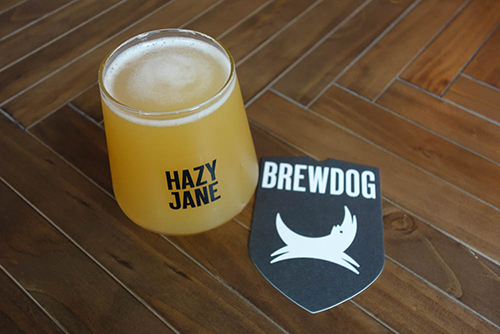
BrewDog in Bristol (One of two – what a lucky city)
July 27, 2022. Berlin, Germany to Bristol England.
Today we were off to tour England and Scotland, then North and South Ireland and Wales.
To get to the airport we again we used our €9 monthly ticket.
We arrived at Berlin’s Brandenburg airport much too early, so had time to kill.
Once the check-in and boarding process started, we found that security was a shambles.
There were no instructions about what to do but you got yelled at if you did the wrong thing.
Then our Easy Jet flight was forty minutes late in leaving.
All in all it wasn’t a great experience.
Once in Bristol we got from the airport to our accommodation, The Ashville, without any issues.
The taxi service was private and you paid up front, once you gave them the destination.
In the afternoon we walked into Bristol to get a United Kingdom SIM card and some equipment to monitor Thea’s recovery progress.
The Ashville turned out to be a steak house as well as hotel. If we had known, we would have booked a table for that night’s dinner.
However when we enquired we discovered that it was booked out.
We then went looking for dinner in Bristol but in the process happened upon a Brew Dog Craft brewery and had a pint. Well Thea had a glass of wine and I had a pint and bloody good beer it was as well.
Most of the restaurants seemed to only be serving drinks, not food.
Eventually we found Pitcher and Piano, which was right in the dock area of the River Avon.
It had a very mixed cuisine, that wasn’t that bad.
Little did we know just how hard it would be to find an evening meal in England.

Banksy in Bristol (Well Hung Lover)
July 28, 2022. Bristol England.
In the morning we went searching for Banksy in Bristol. This trail was suggested in the tourist guides as Bristol is regarded as a good place to see his street art.
Banksy is an anonymous street artist who started working in Bristol’s underground scene around 1990.
We felt it wrong to pay £5 each to get an app showing his art, especially when he has never wanted it to be commercialised.
Thea then found a map, showing the location of his art, on the internet and that was free.
Following this map also gave us an opportunity to explore Bristol.
It was graduation time at the Bristol University and there were academic gowns everywhere. As well as frocked up young ladies and besuited young men.
We then found Java for a lunchtime coffee.
This was a very comfortable restaurant, bar and deli, with huge seating area, all fitted out with leather armchairs.
How very British.
We then continued to wander around the city and came across the Clifton Suspension Bridge.
Opened in 1884, this 412 metre wide bridge spans the Avon River at a height of 101 metres. It was designed in 1830 by Isambard Kingdom Brunel, (1806-1859) a British civil engineer and mechanical engineer, who never got to see his design completed.
Just up the hill from the bridge is the Clifton Observatory.
Completed in 1766, it was formerly a mill and has had various owners.
It is currently owned by Honorbrook Inns, who were obliged to maintain public access to the camera obscura.
From there we continued our walk and finished up down at the Bristol Docks.
There we saw another of Isambard Kingdom Brunel’s designs, the SS Great Britain.
This was launched in 1883 and owned by the Great Western Steamship Company.
This steamship was the largest passenger liner in the world from 1845 to 1854 and transported passengers from Bristol to New York City.
It was also full of maritime innovations, like a iron hull and screw propulsion, all courtesy of Brunel.
No wonder he was known as the the Architect of Bristol.
The last tourist event of the day was finding another Banksy. This one was just a painted statement on a factory wall.
Since it was first created the wall has had a door put in but the art still remains intact.
Now it’s very disjointed and certainly not as Banksy intended.
Before we returned to the hotel we stopped at Brewdog at Harbour Side for a pre dinner beverage.
What a lucky city Bristol is to have two Brewdogs.
This Scottish craft brewery chain is extremely socially aware and very innovative.
This particular one shares 50% of the profits with its staff, has tampons and pads in the gender neutral toilets. It even has a bike station, on site, and a place to lock up your bike as well.
And finally, ‘K9 Hydration Station’ inside the pub.
That night we ate in at The Ashville.
There was no point staying at a steak house without at least trying the food.
It was rather good and certainly not hard to get back to our rooms afterwards.
July 29, 2022. Bristol to Seahouses, England.
After breakfast and then checking out, we got an Uber to pick us up and take us to Enterprise Rent-A-Car, where we were due to pick up our rental.
The Uber was not a pleasant experience.
The driver wouldn’t get out to help us, the car was dirty and full of crap. Also Thea’s seatbelt was missing in the back seat and she had to sit in the middle.
Our rental car was late arriving at Enterprise, so we had to hang around and wait about an hour.
We were not happy about this, as we had to drive from Bristol in the south west to Seahouses in the north east.
When our car eventually arrived, it was a five door Vauxhall Crossland SUV, six speed manual.
I could see that I was going to spend most of my driving time in Britain changing gears.
It was just over 550 km to the coastal town of Seahouses.
Because we were tight on time, we took the motorways, however it was still a very slow trip, with constant stops.
Once we reached Seahouses, we couldn’t get into our guest house, as the door had been double locked.
Fortunately the host had a mate, who lived close by and he came and sorted it out.
After having to miss out on the wedding in Rome, we decided to catch up with Rob and Lorraine.
They were travelling around Britain, as part of their post wedding holiday and this was the only opportunity we had to see them.
Hence the long drive.
Fortunately they had booked an Italian restaurant for dinner, as it was very crowded.
It wasn’t a late dinner, so I worked a bit once we were back in the room.

Bamburg Castle
July 30, 2022. Seahouses, England.
Today was going to be spent touring the local area with Rob and Lorraine and the first stop was Bamburgh Castle.
Built in the 11th Century this area has a lot of history.
Before the castle was built on the site, it was home to a fort of the indigenous Celtic Britons from 420 to 547 AD.
They were known as Din Guarie.
Lord William Armstrong, an exceptional scientist, engineer and inventor purchased Bamburgh in 1894.
He is regarded as the inventor of modern artillery and had a lot to do with the development of hydroelectricity.
The castle is home to his unique collection of artwork, ceramics and objets d’art.
Lunch was at the Copper Kettle Tearooms in Bamburgh Village.
In the afternoon we walked on the Bamburgh Beach and then continued on to the Harkess Rocks Lighthouse, which is right on the point at the end of the beach.
The rather cuboid building, with the lighthouse on top, does have a very comical face.
That night it was a pre dinner drinks at the Ye Old Ship Inn, with a great Neck Oil Session IPA from Beavertown Brewery.
We then had dinner at a local Indian Brassiere, with small portions and not a lot of flavour.
A bit of a disappointing end to an adventurous day.
July 31, 2022. Seahouses, England to Inverness, Scotland.
After leaving the Grahams in Seahouses, we had another day of driving, this time to Inverness in Scotland. It was just under 400 km and a much easier drive than we had from Bristol.
What made it more pleasant, was that we weren’t on motorways and the scenery was much more interesting.
The other plus was that there weren’t the holdups we experienced coming north.
Once we got into the room at the Smithton Hotel we then had a drive around Inverness.
The GPS had no idea where the centre of town was. Which wasn’t surprising considering it was in a pedestrian area.
Dinner was at the hotel.
The beer offering was rather weird, with English, Irish, French, Scottish, Italian and, the formerly Australian brand, Fosters.
It’s strange that this formerly iconic Australian, that’s the largest selling Australian brand in the world, is dead at home but still lives on in the United Kingdom.
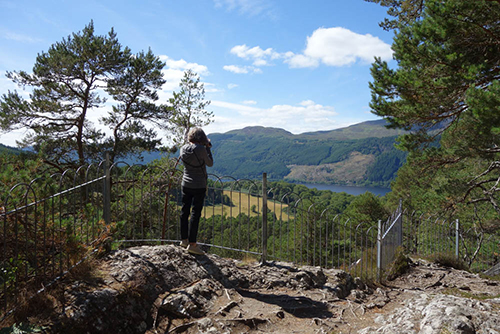
The Highlands with Loch Knockie
August 1, 2022. Inverness, Scotland.
The morning was spent planning our next moves and then we had a drive around Loch Ness.
Unfortunately no sightings of ‘Nessy’
Loch Ness was quiet on the south, east side but very busy on the other.
People were starting to travel again after Covid and tourists were everywhere.
We drove to the Falls of Foyers and then into the Highlands where we got a view of Loch Knockie.
Later that afternoon we visited the small village of Drumnadrochit, which sits at the western end of Loch Ness.
The Smithton Hotel was a way out of Inverness so dinner was again in-house.
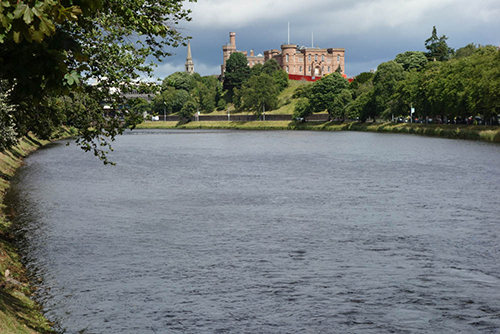
Inverness Castle over the River Ness
August 2, 2022. Inverness, Scotland.
We drove into Inverness to explore the city and found a city parking station. We didn’t want to be constantly worried about an expired meter.
Our landlord told us not to leave too much time to explore the city, as there wasn’t much to see.
In a way he was right.
We found a good coffee at Coffee Affair and then afterwards walked around town, then along the River Ness.
The castle was under renovation, so unfortunately not as photogenic as it normally would have been.
It was then a short drive to visit the Clava Cairns, This is a 4,000 years old Bronze Age circular chamber tomb cairn.
There are about 50 of this type around Inverness.
We considered visiting Cawdor Castle, however at A$50 for the two of us, we gave it a miss.
This is our last night in the Smithton Hotel. Where there are more stairs and doors than I’ve ever experienced.
It was a rabbit warren.
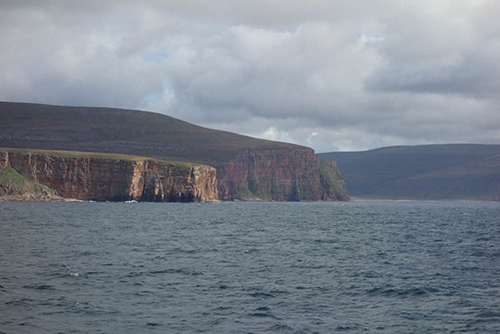
Our first glimpse of the Orkney Islands
August 3, 2022. Inverness to Finstown, Orkney Islands, Scotland.
We were up early for another day of travelling.
Firstly by road to the port of Stromness, then by the NorthLink ferry, Hamnavoe, to Scrabser and finally back on the road again to Flinstown, near Kirkwall.
This is in the Orkney group of islands, situated in the very north east of Scotland.
Getting accommodation in this region has not been easy. In fact the only reason we found the ‘Shepherd’s Hut’ was via the suggestion of another place, that was booked out.
This cottage had only just come onto the market and the owner hadn’t been able to get a listing on Bookings.com or Airbnb.
It was set up for self catering, so we were back to cooking for ourselves for a change.
This trip to the Orkney Islands has been on the wish list for some time.
Within this group are the Islands of North and South Ronsldsay.
Our family home in Hampton was called Ronsldsay or Ronaldshay and was named by the origin owner, after his place of origin in Scotland.
He was a sheep farmer in the Western District of Victoria and, not surprisingly, the islands of Ronaldsay are famous for their sheep.
Apparently those sheep live off seaweed.
The house was his city retreat and fitted out with servants quarter and bells in the billiard room to summon them.
He clearly wasn’t struggling.
‘The Pub With No Beer’ is a well known Australian song by Slim Dusty.
Well we are in a ‘town with no pub’
After settling into our very small accommodation in Flinstown, we decided that we needed to find a Scottish pub and have a pre dinner drink.
Easier said than done.
There was nothing in nearby Kirkwall, and this is the largest town on the Main Island. So we drove back to Stromness and found the Ferry Inn.
Like everywhere within the town it was packed, luckily we were only having a drink, as standing at the bar was our only option.
Brexit clearly has something to answer for, as so many places we had visited were struggling to find staff and either shut or operating on limited opening hours.

FD68 ZNU near Marwick
August 4, 2022. Finstown, Orkney Islands, Scotland.
A drive around the Main Island, starting with Neolithic Orkney.
This is the name given to this area by UNESCO in 1999, after it was proclaimed a World Heritage Site.
The history here goes back 5,500 to 6,000 years.
Within the area is the Ness of Brodgar, the Standing Stones of Stenness and the Ring of Brogdar.
Around the world middens are very important in archeological digs.
A midden is really just a dumping ground for peoples waste but when they are excavated centuries later, they shine a very bright light on just how the locals lived at the time.
The Ness of Brodgar, is an archaeological dig that dates from 3,500 BC.
Here digging up the middens is imperative to tracing the history of the people and the area.
Farming is a way of life here and has been since before time. They are constantly discovering just how resourceful the locals were back then.
We tried to get to the Ring of Brogdar but the rain had arrived and it was just too wet.
We visited the Orkney Brewery for lunch, all washed down by a tasting paddle of their excellent craft beer.
In the afternoon we visited Saint Magnus Church (1664) and then Earl Robert’s Palace (1574)
We finally ended the day at the Rendall Doocot (1668).
A Doocot is a structure designed to house pigeons, which would provide food for the owner’s family.
This one was constructed in the ‘beehive’ style and still has some residents.
It was then back to our tiny room to cook the evening meal, which wasn’t pigeon.
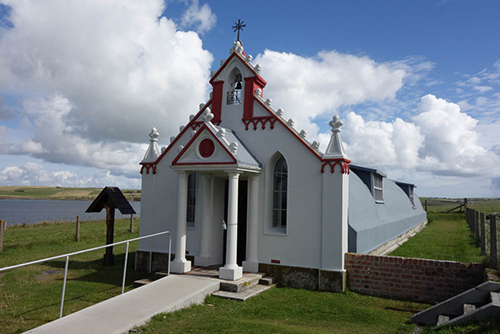
The Italian Chapel
August 5, 2022. Finstown, Orkney Islands, Scotland.
Touring again today, this time to the island of South Ronaldsay.
Our first stop was the Churchill Barriers and Italian Chapel, these were both a consequence of WWII.
The Churchill Barriers, built between May 1940 and September 1944, were designed as a defence to protect the anchorage at Scapa Flow.
Now they have become roads links between the islands, however you are still reminded of their original purpose by the occasional upturned hull of a sunken ship.
Of the four barriers there are only two remaining. This is a result of bad weather and rising water levels due to climate change.
The Italian Chapel, on the other hand, is in beautiful condition.
This highly decorative Catholic chapel was built by Italian prisoners of war, who were housed on the island, while they built the Churchill Barriers. The chapel was only completed after the war and then restored in the 1960s.
It was built using two Nissen huts joined end-to-end. The interior corrugated tin walls and ceiling were covered in plaster board and then decorated.
Most of the interior was painted by Domenico Chiocchetti an Italian prisoner from Moena.
We then drover to the very south of South Ronaldsay and explored the small village of Burwick.
After dinner, back in the cabin, we spent the evening working.
I had a few jobs for BTB, while Thea tried booking the next part of our stay in Scotland.
This wasn’t easy as so much was booked out.
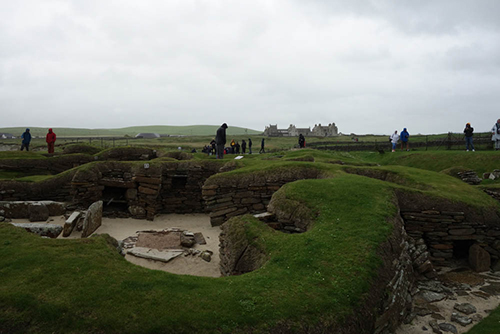
Scara Brae (Europe’s best preserved stone village) 5,000 years old
August 6, 2022. Finstown, Orkney Islands, Scotland.
First task was to visit the the Brig Larder to get dinner.
We had discovered this amazing food store a couple of days earlier when we briefly explored the small town of Kirkwall.
It specialised in the local foods from the Orkney region and there was a huge variety to choose from.
Then some more sightseeing.
First stop was Scara Brae, dating back 5,000, this is Europe’s best preserved and most complete Neolithic stone village.
It’s a UNESCO World Heritage Site and older than Stonehenge and the Great Pyramids of Giza.
There are ten clusters of houses, that even have a primitive sewerage system with flushing toilets and drains in each house.
It was discovered after a storm in 1850 and unfortunately, due to climate change, is under threat today.
After that we visited Skaill House, which overlooks Scara Brae.
Originally started in 1620, by Bishop George Graham (1565–1643), it has been extended over the years and is now a three story mansion spread over a large area.
It had rained all day so we decided to get a drink at the Orkney Brewery – again.
This place was becoming a regular.
Well it was warmer and dryer than being outside and the beer is good.
It’s owned by Sinclair Breweries, which is the parent company of Orkney and Atlas Ales.
Founded in 1988 it is one of the oldest microbreweries in Scotland.
The brewery supplies beers to UK, Europe, Australia, Canada and the USA.
Unfortunately I haven’t found any of their beers in Australia yet.
We were going to go to the local restaurant by the lake for lunch but decided that there was still too much to see. So we kept on sightseeing right through the afternoon.
That nigh was another dinner in the hut, all from the food purchased earlier at the Brig Larder.
As I looked out the window onto the green fields, with the grazing cows, I realised that this area has been farmed for well over 5,000 years.
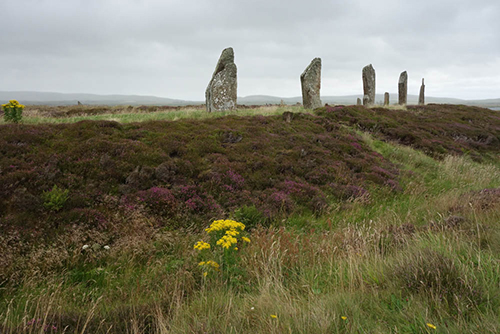
Ring of Brodgar (3,000 BC)
August 7, 2022. Finstown, Orkney Islands, to Thurso, Scotland.
We checked out of the Shepherd’s Hut, which involved locking the doors and driving away and then drove into Kirkwall, where we had real trouble finding a coffee.
Nothing was open.
Then to the Ring of Brodgar, which we had tried to visit before but were stopped by the rain.
This Neolithic stone circle, built between 2500 BC and 2000 BC, is the largest in Scotland and regarded as one of the world’s finest.
It is very wide, with a diameter of 103.7 metres. The stones are laid in a perfect circle around the perimeter.
We arrived at Stromness but were far too early to catch the ferry, so we walked around this quaint harbour town.
It didn’t take long.
Then we boarded the boat to Thursto.
That night we were staying at the Manor House and would be there for a couple of nights.
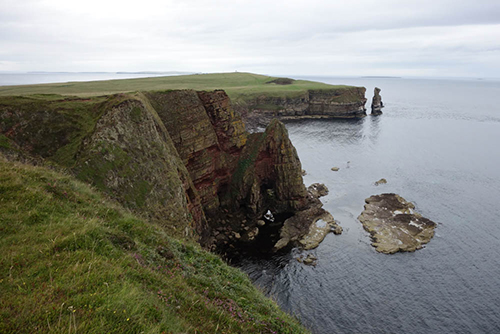
Duncansby Head
August 8, 2022. Thurso, Scotland.
It was Cafe Olive for breakfast, where they had a very interesting take on Avocado Toast.
Unfortunately their espresso machine was broken, so we had to find our coffee elsewhere.
When we did find one, it was expensive rubbish.
We then drove to John O’ Groats, Britain’s most northern point.
At lunchtime Thea had a Scottish scone and I had another coffee, hoping it would be better than the morning one.
It wasn’t, so this had become a bad coffee day.
We then drove to Duncansby Head and walked to view the Knee, Gibbs, Pedie and Muckle Stacks.
‘Duncansby’ what a wonderful amalgamation of my middle and surname.
I truly must have Scottish heritage.
On returning to Thurso, we decided we needed to find the tourist information centre, then get petrol and some cash.
We found a servo easily enough and the petrol price was cheaper than down south.
The information centre was closed and this was only 4pm on a weekday in August, at the height of the tourist season.
Even one of the nearby ATMs was shut.
I think everyone has gone on holidays.
We had dinner at the Pentlandite hotel.
The meal was fine but what was a surprise was the American tourists who were dining near us.
When the time came to pay, they were offering a 20% tip. The bar staff didn’t know how to cope with it and suggested putting money in the ‘Tip Box’.
It’s this ignorance of local customs by the Yanks that screws it up for us all.
Now everyone who comes into the pub and speaks a ‘strange’ version of English will be expected to tip 20%.
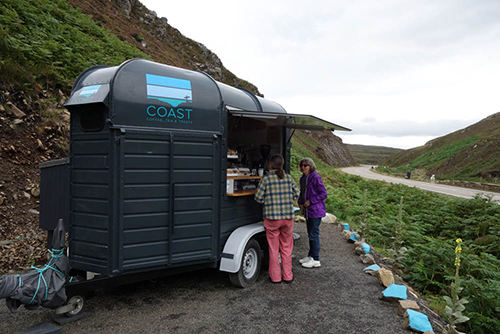
Coast Coffee van
August 9, 2022. Thurso to Ullapool, Scotland.
It was third time lucky, with coffee at Coast, a caravan on the main road.
This little pop up van served a great cup of espresso. So much so that we decided to forgo another cup during the day, so as not to ruin the taste of our first one.
It wasn’t a long drive to Ullapool but it was a tricky one.
There were long stretches of single lane, narrow, roads. You could only pass at the designated ‘Passing Points’ and there were busses and many motor homes to squeeze past.
Many of the vehicles were from Europe, so you had to see what side the driver was on before you waved acknowledgement of their courtesy.
Most of the drivers were good and didn’t show the usual impatience.
We arrived in Ullapool around 3:30pm and decided to check out our dinner options.
Even then, everywhere seemed to be packed so we went and checked into our B&B and headed straight back into town.
I think we were in for an early dinner.
The Ferry Boat Inn was the closest and had a good menu. It also had great views looking over the harbour.
Thea had tried to book a table at the Ferry Boat Inn, by phone, a few day ago but was told they only accepted ‘walk-ins’.
When we arrived the place had a couple of tables reserved but the rest were empty. However when people came in and tried to book they were told that it was full.
Apparently it’s all due to staff shortages again.
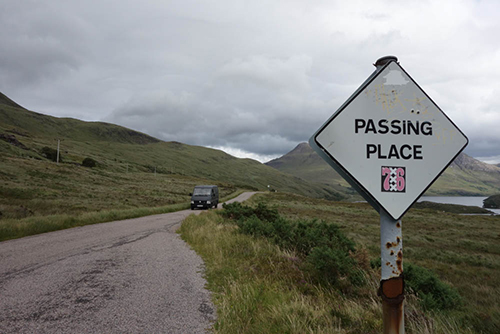
Passing Places
August 10, 2022. Ullapool, Scotland.
Ullapool is not cheap.
Last night’s dinner and this morning’s breakfast have been the most expensive, so far, on this trip.
I think the locals are making up for lost time – and money.
We visited Knockan Crag in the early afternoon.
This crag became a huge debating point amongst geologist during the nineteenth century.
It became known as the ‘Highlands Controversy’ because it appeared that the rocks at the top of the crag were older than those below and were from a different age.
In the end it was the geologists, John Horne and Ben Peach, who discovered the reason for this upside down geological wonder.
They demonstrated that the strange phenomenon was the result of a ‘Thrust Fault’. This was where a tectonic action had caused the older rocks to be moved 70 kilometres to the west to cover the younger rocks.
Our science lesson was then followed by an afternoon coffee at the Elfin Tearooms.
Yes, the tearooms had an espresso machine, but it’s no wonder, the owner was an Australian.
And the coffee was great.
Then, after that a ‘wee’ drive to Achiltibuie.
We had dinner, which was simple but good and then met Fergie and Sambo at the bar in the Arch Inn.
This was a disaster, of the best kind.
These two locals had not only visited Australia but had relatives living there. They wanted to chat and drink and insisted on buying us rounds, even though we objected.
In the end I spoke to the barman, who was a friend of theirs, and gave him some money to buy them a round, when next they were in. I was sure that wouldn’t be too far away.
I hope they got my shout.

Bridge by Sir John Fowler (designer of the Forth Rail Bridge)
August 11, 2022. Ullapool to Fort William, Scotland.
We we’re staying in a B&B in Ullapool but there was one problem.
They only provided the bed, not the breakfast.
This was compounded by the fact that finding breakfast in town was difficult.
So, on our second day, it was a takeaway, sitting on a bench, in the main street.
We did get a good coffee afterwards at the Cult Cafe. This was the expensive venue for yesterday’s breakfast.
Off to Fort William today.
On the way we stopped for a stroll in Lael Forest Garden. Developed in 1800s it boasts 200 different species of trees and shrubs.
Just over the road from the forest walk is an old steel bridge, passing over the River Broom.
It was designed by Sir John Fowler, designer of the Forth Rail Bridge.
Lunchtime coffee was at the Wee Bun House, near the Glenshiel Bridge.
The Croit Anna Hotel, our accommodation in Fort William, was a fair distance out of town, so we decided to eat in.
This was thwarted when we discovered that we should have booked on arrival, as it was full.
We then decided to get a taxi into town. Again this wasn’t to be as they either didn’t answer of weren’t available.
So we drove.
I had noticed a brew pub, on the way to the hotel and decided to go there.
It was so crowded that the patrons were eight deep at the bar.
However just near where we had parked the car we had noticed an Indian restaurant, Spice Tandoori, so we finished up there instead.
It was huge inside and very efficient with its service.
The food was also rather good.
After dinner we walked around the main shopping area and it looked pretty interesting.
We will have to return.
Our remote hotel was the result of scarce accommodation availability.
Crowds and scarcity of eating options have been a constant reminder of everyone’s rush to get back to travelling.
Especially by the Europeans, they are everywhere in the Scottish Highlands.

The decent
August 12, 2022. Fort William, Scotland.
The weather was improving as we headed south.
I could be back into shorts soon.
Back in the walking street in Fort William, that we explored the previous evening, we found ‘The Wildcat’ a vegan cafe that served sustainably sourced coffee.
Then it was off to discover Ben Nevis. At 1,343 Metres high, it’s the highest mountain in all of Great Britain, not just Scotland.
You don’t climb Ben Nevis but get a gondola to the viewpoints, where you look at it from a distance.
This was the only mountain gondola system in the UK.
Since 2016 the system has been powered by hydroelectricity.
When we reached the viewpoint, Ben Nevis was actually behind us and rather unimpressive.
It may be the tallest mountain but not by much.
It was then off to the Commandos Memorial, who trained in the area between 1940 and 1945.
It was unveiled in 1952, as a result of a competition won by Scott Sutherland (1910-1984) who caste it in bronze.
We decided to go back Into town for dinner and booked a taxi early.
It was meant to arrive in 20-25 minutes and it came in 30.
Not too bad.
Dinner was at the Ben Nevis Hotel, how fitting.
Afterwards we finely got to the Black Isle Brewpub and I had an IPA, which was great.
The first draught craft beer I’d had in a while.
Getting a cab back to the hotel was another interesting experience.
The cabs were so hard to find, that we ended up sharing one with a couple of other people. One of our fellow passengers was a staff member at the Croit Anna Hotel, the same one we were staying at.
She happened to be from Ukraine and had a few good stories to tell us on the journey home.
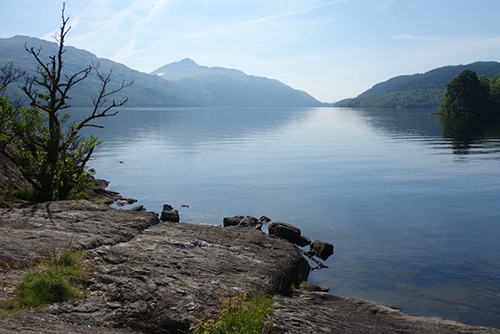
Loch Lomond
August 13, 2022. Fort William to Glasgow, Scotland.
We were off to Glasgow for four nights and staying not far from the centre of town.
On the way we drove past Lochs Eil and Lomond and then the Loch Sloy Hydro-electric power station.
This power station was built from 1949 to 1951 and is one of the largest.
We then continued our journey into Glasgow.
Once we had settled into our hotel, The Holiday Inn Express, we had a pre-dinner walk around the city to get ourselves acclimatised.
Glasgow isn’t the capital of Scotland, that’s Edinburgh, but it is the largest city and in fact one of the largest cities in Europe, It was the European Capital of Culture in 1990.
There are two distinct walking areas, near our hotel.
Sauchiehall Street, which is rather run down and down-market. Then there is the West Nile Street area that is full of up-market shops, restaurants and arcades.
We popped in for a pint (well that’s what I had) at the Shilling Brewing Company on George Street.
This was another brewpub and the first to be established in Glasgow.
Located in the former Art Deco premises of the Commercial Bank of Scotland, it was a real brewpub experience, with brewing equipment and over 30 craft brews on tap.
Dinner was at Döner Haus, a German, Turkish fusion restaurant.
Strange but good.

The Peoples Palace (1898)
August 14, 2022. Glasgow, Scotland.
Breakfast was in the hotel, as it was included in the room rate.
It was a Sunday so the streets were quiet. That’s until we got to the walking streets and they were still very crowded, as many of the shops were open.
Heavy rain was promised later in the day, so we headed out to do some more exploring.
Coffee was our first task – of course.
Then we walked through the park besides the River Clyde, and up to the Peoples Palace.
Glasgow Green, surrounding the Peoples Palace, was all fenced off due to the recent World Pipe Band Championships, 2022, so we had to walk the long way round.
Within the Peoples Palace was an exhibition showing the social development of the city.
Established in 1898 the People’s Palace was originally built as a peoples refuge, as this part of Glasgow was regarded as one of the poorest.
Since the 1940s it has been a museum of social history, which was reflected by the exhibition that was currently showing.
Then it was back into the centre and our hotel.
Some onward planning was required.
Dinner was O’ Sole Mio, an Italian restaurant. This wasn’t surprising as there were a lot around the Theatreland area, where we were staying.
But before that we returned to the Shilling Brewing Company and this time sat outside.
The weather was still rather mild.
However, as we were having dinner, the rain came down and it was torrential.
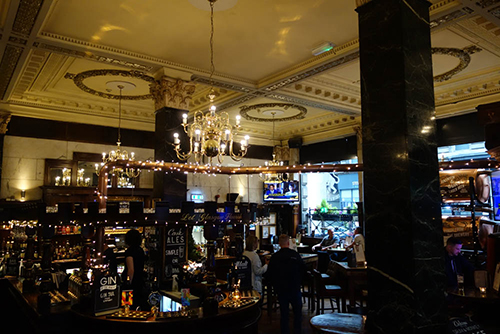
Drum & Monkey
August 15, 2022. Glasgow, Scotland.
In the morning it was still raining and the temperature had dropped.
As part of her medical assessment, Thea needed to get another blood test.
Through Boots the chemist, she had been given a few numbers to contact and arrange the test.
Success at the first call.
She made an appointment at 11:30am, so the morning coffee went on hold.
Better not to be caffeinated before a blood test.
Not much happened in the afternoon as the rain persisted.
Dinner was at the Drum & Monkey.
This was located on St Vincent Street, in another old bank building, that was converted to an American style pub in the 1920s.
The name Drum & Monkey comes from the area in St Vincent Street that marks the British sea victory over the Spanish in 1797. Here, travelling showmen would have performing monkeys who would often play a drum.
The service was slow and the food ordinary and expensive. They specialised in pies, so we ordered them. Then it was a long wait until ours arrived and by then they were extremely over cooked.
I think the monkeys might have done a better job.
If we hadn’t paid for the meal up front, we would have walked out.
In fact, I think that most places now want their money first. They realise that their lack of service and offering would normally result in people walking out if they could.
I wrote a scathing review on Google, however I doubt it will ever be published.
As a reward for putting up with the Drum & Monkey we returned, yet again, to the Shilling Brewing Company for a post dinner drink.
This is becoming a favourite.
Well, the atmosphere, building and drinks are great.
And it’s cheaper than a lot of other places.
After a few days here, I have decided that Glasgow is a great city to visit.
It’s easy to get around and there is wonderful choice of places to visit.
Plus the architecture is amazing.
Glasgow is famous for its Victorian architecture and early 20th Century ‘Glasgow Style’ as developed by Charles Rennie Mackintosh (1868 – 1928).

Kelvingrove Art Gallery and Museum
August 16, 2022. Glasgow, Scotland.
There was still a constant drizzle in Glasgow.
We had booked an extra day, so we had to get out and explore some more.
In this sort of weather, the car was the best option.
We spent some time in the Kelvingrove Art Gallery and Museum.
One of the highlights was an exhibition of the Glasgow Boys. This was a group of young artists that represented the start of Modernism in Scotland in the early 1880s.
Painting ‘en plein air’ was their specialty.
Another interesting exhibit was the Anderson Special, a race car built in the 1930s.
It was a low slung vehicle that could compete in hill climbs, sprints and country climbs. With 4WD and the engine mounted beneath the floor, it was far ahead of its time.
The museum and gallery were another good opportunity for us to understand Glasgow’s past.
A real highlight for us was a small stained glass window, very similar in style and colour to the billiard room windows in 10 Ocean Street in Hampton.
I often wonder if the sheep farmer from Ronaldshay, who built Ocean Street, sourced his stain glass from Glasgow.
In the afternoon we went chasing ghosts. Thea had arranged a route that passed many of the old areas that my relatives had lived in.
We visited the Smugg Coffee Bar in Hillhead for a late coffee and got parking right out the front, and it was free.
Hillhead is where my great aunt, on my mother’s side, lived.
The area was rather nice and probably very similar to what it would have looked like back in the 1920s.
Well at least the houses.
Free parking in the UK is rare, as we were alerted to by the landlord of the Smithton Hotel in Inverness.
It was still drizzling when we arrived back at the hotel.

The Kelpies (35 metres high)
August 17, 2022. Glasgow to Edinburgh, Scotland.
It’s only about two hours from Glasgow to Edinburgh but Thea had organised a few side trips along the way.
Some of these involved more ghost chasing.
But first another walk down Buchanan Street.
Glasgow Subway Ticket Office, built in 1896, is the third oldest underground metro in the world. The six and a half mile of track was initially cable-hauled until it was electrified in 1935.
An hour and a half out of Glasgow was the Falkirk Wheel, built in 2004, it connects the Union Canal to the Forth and Clyde Canal.
It’s the world’s first and only rotating boat lift.
It rotates 180° in under 5 minutes and can carry the weight of 100 elephants.
‘The Kelpies’ were next but they aren’t dogs, as you would expect by the name.
This is a 35 metre tall sculpture of two stallion heads and is just near the Forth and Clyde Canal.
Completed in 2013, by the sculptor Andy Scott. They are said to represent the heavy horses of Scottish industry and economy pulling wagons, ploughs, barges and coal ships that shaped the land of the Falkirk area.
Whatever you say Andy!
Then it was ghost chasing time as we weaved our way to Edinburgh.
Teuchters Landing for dinner.
This was a brew pub, on the docks and only 6 minutes walk from our hotel.
Most of the seating was either outside or exposed to the weather.
Lucky we took our coats.
The food choice was wide, as was the range of beers and wines.
Again there was a large contingent of Europeans.
Scotland seems to be the alternative destination this summer.
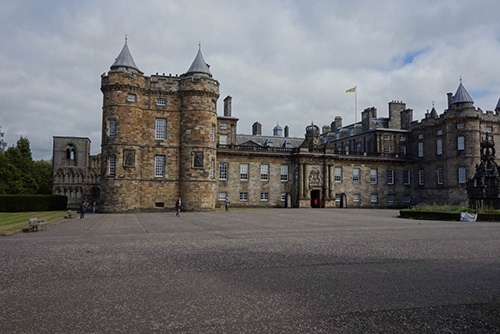
The Palace of Holyroodhouse (One mile down from Edinburgh Castle)
August 18, 2022. Edinburgh, Scotland.
In Edinburgh we were staying at the Holiday Inn Express. This was right near the waterfront.
We stayed with the same hotel group in Glasgow and were very pleased with the staff and service.
The same applied in Edinburgh.
Breakfast was included and rooms were clean, spacious and comfortable.
It was Clock On The Shore for morning coffee. This was a local coffee shop a short walk from the hotel.
We then got the bus into town.
The bus driver seemed to be a ‘Grumpy Bum’ as he snarled at the other drivers and wasn’t that friendly to some of the passengers.
However Thea engaged him in conversation and he was a different person.
After leaving the bus we then walked up to Edinburgh Castle. From there we did the Royal Mile.
This runs from the castle to The Palace of Holyroodhouse and is exactly one mile or 1.6 km.
It was first popularised in 1901 by W. M. Gilbert’s ‘Edinburgh in the Nineteenth Century’. Here he described it as the city with a castle and a palace with the royal mile between.
After walking the Royal Mile we then walked a few more miles back to our hotel.
Dinner was at the King’s Wark, originally built in 1534 for King James 1, as his residence and armoury.
This was a last resort for dinner, as many places were either shut or booked out.
It turned out to be a good choice.
Unfortunately the beer wasn’t great so we finished off the night back at Teuchers Landing.
This was where we had dinner the previous night.
The beer was great and the wine cold, so we were both happy.
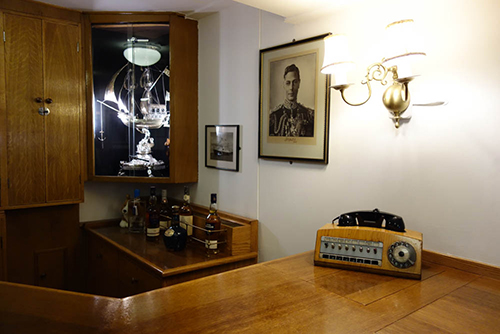
The Royal Yacht Britannia
August 19, 2022. Edinburgh, Scotland.
Morning coffee at ‘Irish Dude Coffee and Food’.
It wasn’t easy to find because of the roadworks surrounding our hotel.
These works are due to the construction of a new tram line from Edinburgh, to the Ocean Terminal, which is right next to our hotel.
They were started in 2019 and are expected to be completed next year.
Due to the works, we struggled to get to our hotel when we first arrived. Now just walking around the area is difficult, as the usual pedestrian access has been blocked.
Once we did find a way around, we then walked to the Royal Yacht Britannia.
There we booked an audio tour, which lasted about 90 minutes and despite the crowd was very efficient.
The yacht is moored next to the Ocean Terminal shopping complex and you actually board from there.
Britannia was built in 1954 by Queen Elizabeth II and was decommissioned in 1997.
During her 43 year career the yacht travelled over one million nautical miles around the world, visiting 600 ports in 135 countries.
Dinner was at The Barologist, a pub in the house of a former inventor, George ‘Geordie’ Armstrong, also known as, Ulysses G Houston.
It appears from information on the pubs website that he was friends with Phileas Fogg, who is a fictitious character created by Jules Verne and Johnnie Walker (1805–1857) maker of the famous whisky.
He lived in the house, now pub, between 1884 and 1904, which I only discovered after finding a plaque on an outside wall.
I did question the staff as to the history of the place but was greeted by blank stares.
This all leads me to believe that the entire story of the Barologist is made up.
However it still makes for interesting conversation and conjecture.
One thing we have noticed in the UK, so far, is that the beer and wine are never really cold and the food lacks flavour.
There seems to be a fear of adding herbs and spices to any food.
The Brits never want to offend, or as Monty Python often said “Sorry”.
However the hot water in the hotels and public conveniences is usually boiling.

Colinton Tunnel
August 20, 2022. Edinburgh, Scotland to Carlisle, England.
Today we were travelling to Carlisle, which was just over two hours to the south.
Or first stop was in Colinton, which was still within the city of Edinburgh. There we found the Colinton Tunnel. This is Scotland’s largest mural, which was created as a community art project in an abandoned railway tunnel.
The art work is stunning.
Rosslyn Chapel, in the village of Roslin, was our next stop.
This was made famous in Dan Brown’s novel The Da Vinci Code in 2003.
There was a theory that this Catholic church had a connection to the Knights Templar, the Holy Grail and Freemasonry, all subjects featured in Brown’s book.
This is a fact that Medieval historians deny ever happening.
Why spoil a good story with the truth.
Unfortunately we couldn’t get in as it was booked out for the day. We hadn’t pre booked tickets and a time slot, as it was a last minute decision to go.
Another result of this summer’s frantic tourist invasion.
We were staying in an AirBnB in Carlisle. So once we got into our rooms and established what was provided and what wasn’t, we headed off to shop and found a huge Sainsbury, with a car park that was relatively close by.
We had a kitchen once again, so dinner was eaten in.
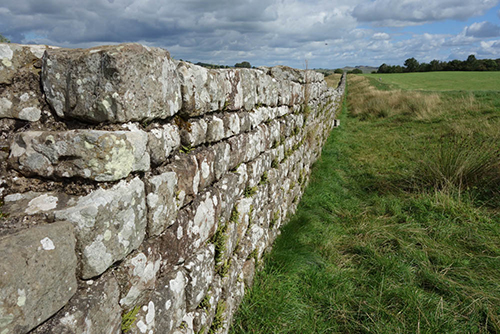
Hadrian’s Wall (AD122)
August 21, 2022. Carlisle, England.
After breakfast in our apartment, we went out to find coffee, as usual.
We ended up at Espresso Hub, a cafe and coffee roaster in the Lanes Shopping Centre area.
A coffee roaster!
This looked promising, unfortunately the coffee wasn’t great.
We then went wandering around trying to find the best off-street parking near our rooms for tomorrow.
Our AirBnB allowed us to use office parking spaces, close by, during the weekend but we had to find an alternative during working hours and this was a Sunday.
In the afternoon we drove to Hadrian’s Wall.
We were going to explore this on the previous day, while travelling to Carlisle, but the weather was just too wet.
Hadrian’s Wall, built around AD122, ran for 117km across the width of Scotland.
It was built as a frontier defence of Britannia, by the Roman Emperor, Hadrian, against the ravaging hoards of the north.
It is now a UNESCO World Heritage Site.
We then stopped off at Lanercost Priory, which was founded by Robert de Vaux between 1165 and 1174.
One of its claims to fame, is that the Lanercost Chronicles, which were a history of England during the Wars of Scottish Independence, were written by the monks of the priory.
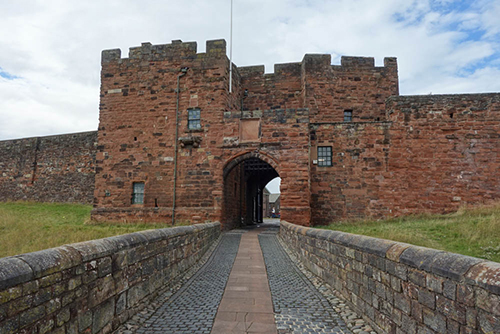
Carlisle Castle (1093)
August 22, 2022. Carlisle, England.
Raining again.
While Europe, and even some parts of the UK have sweltered this summer, we seemed to have mostly copped cool and wet conditions.
I prefer the warmth.
Once we sorted out our parking, as it was now Monday, we walked to Carlisle Cathedral.
It was first founded as an Augustinian priory and became a cathedral in 1133. It’s the second smallest of England’s ancient cathedrals and decorated in the Gothic style.
Carlisle Castle was next.
This Medieval stone fortress was built by William II in 1092.
For over 930 years this fortress has been a centre of war and invasion.
It was the last English fortress to undergo a siege, which was during the Jacobite Rising of 1745/6.
After the cathedral and castle we walked back through Britts Park.
Created around the turn of last century, it runs beside the River Eden and is lush and green, which is to be expected considering all the rain we’ve had.
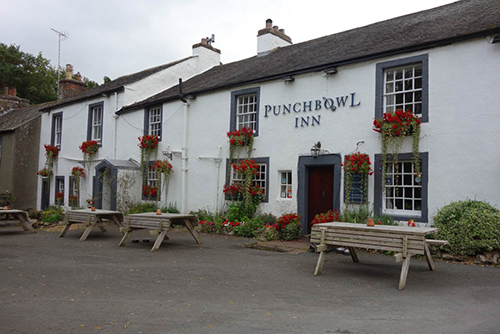
The Punchbowl Inn in Askham
August 23, 2022. Carlisle to Liverpool, England.
On our drive to Liverpool, we stopped off at Askham to do some more ghost chasing, this time on Thea’s side.
We popped in to the Punchbowl Inn, that was in the village and once the home of one of Thea’s distant grandfathers.
We then stopped off for lunch and a coffee in Kendal and at Nina’s.
The coffee wasn’t that bad but Thea’s roll was tasteless.
A pre dinner drink at Doctor Duncan’s, which was next to the Marriott Hotel, where we were staying.
This was practically in the centre of Liverpool which was very convenient.
We finished up staying for dinner as the place was so quaint.
Again the story of the pub’s name was concocted.
Doctor Duncan had nothing to do with the pub or even the building it was housed in.
In fact he was long dead before the building was constructed in 1901.
Unfortunately the choice of food and beverages didn’t live up to the interesting atmosphere.
The food, yet again, was tasteless and the beer and wine choice didn’t inspire.
After dinner we had a walk around the CBD and found The Old Post Office Hotel.
This was relatively quiet, compared to everywhere else, so we popped in for a nightcap.
As we have seen in many British pubs there are many single guys.
Most of the time they don’t look happy.
As we walked around the city, we noticed that there wasn’t as many historic buildings as we had seen in other parts of Britain.
This was due to the ‘Liverpool Blitz’ when the city was heavily bombed between 1940 and 1942. In fact it was the most heavily bombed city in Britain, outside of London.

The Beatles Story
August 24, 2022. Liverpool, England.
We had decided to visit Liverpool to do some Beatles discovery.
Something we had never done when we lived in Manchester. We lived there for two years and stupidly never made the one hour drive west to this port city, home of John, Paul, Ringo and George.
We were both Beatles fanatics in the 60s’ so it was weird that we hadn’t made the trip.
Out of the ones on offer ‘The Beatles Story’ was the exhibition we chose to see.
It was meant to take about one and a half hours but it took me two and a half hours and Thea a little longer.
It was great, however my only criticism would be that the flow was a little confusing.
I had to double back a number times to see things I had obviously missed.
It not only covered the Beatles, as a group, but also as individuals. Plus those people who influenced their lives.
They even had a recreation of the Cavern Club on Mathew Street, the venue that made them famous.
After we had finished the tour we wandered down to Mathew Street and had lunch at the Cavern Club restaurant.
This was just over the road from the new Cavern Club.
The one that the Beatles actually performed in the the 60s’ was closed down in 1973.
On August 19th, 1963, the Beatles, which now included Ringo Starr, played their first gig at this now iconic venue.
They went on to have 297 appearances there, the last one being on August 3rd, 1963.
The Beatles touched many people, from different cultures, as was evident in the signage around the exhibition.
There were instructions in five languages in the toilets.
We had an early dinner, as it was going to be an early start in the morning.
We were getting the ferry to Ireland.
There was however one last drink at Doctor Duncan’s.
The atmosphere was great – pity about the food.
Northern and Southern Ireland.

August 25, 2022. Liverpool, England to Dublin, Ireland.
We were up at 6am and had checked out of the hotel by 7. Then, after retrieving the car from the parking lot, we headed off to find the port.
Today we were headed for Northern and Southern Ireland.
Once we got to the P&O depot at Gladstone Dock, we had to show our passports. Which is something we hadn’t done for a while.
Once aboard the Norbay we were given a complimentary cabin, even though we hadn’t booked one and found that two meals were included in our passage.
All in all a good start to the day.
After breakfast on board we settled into some, not so comfortable, seats and prepared for the seven hour voyage.
It was a long trip but relatively relaxed.
Once we arrived Dublin and disembarked we got the GPS up and running and headed to our hotel.
We had booked one near the airport as we were only staying for a night and wanted an easy exit from the city the following day.
As we were a little isolated from everything, we stayed at the hotel for dinner.
A good choice.
The chef at the Metro Hotel Dublin Airport gave us food with flavour. Something we hadn’t had in a while.
Also we are back to paying in Euros.

Carlingford Castle (13th Century)
August 26, 2022. Dublin, Ireland to Belfast, Northern Island.
Yesterday we moved from Pounds to Euros and now it was moving back again as we headed from Dublin to Belfast.
Not to forget Kilometres to Miles.
On the way we stopped off at Carlingford, a medieval town, on Lake Carlingford.
The castle there told some interesting stories about England and the ruling classes of the time.
Then it was on to Belfast. This was on a very cross country route that took us through small villages, rolling countryside and a few interesting ‘shortcuts’.
Once we got to Belfast we not only had trouble finding the hotel but also the car park.
As I was illegally parked near the hotel the ominous shadow of a parking inspector loomed behind me. As soon as Thea returned from checking in she ‘sweet talked’ him into letting us stay there while we took the cases to the room.
On our return I wondered if he had given us a ticket anyway.
Fortunately he had disappeared and left no ticket behind.
They aren’t all bad it seems.
The Travel Lodge Hotel, where were staying, was rather basic but it was in the middle of town and offered all you really needed.
It’s amazing how you can adapt the room layout to suit your needs.
We had dinner at Actons which was great and just down the road from our hotel.
Another meal with flavour, that’s two in a row in Ireland.
I had a bottle of White Haze IPA, from O’Hara’s Brewing in Ireland.
It was the best craft brew I had had in a while, full of citrus flavours and it was served cold.
A rarity in GB.

Shankill Road
August 27, 2022. Belfast, Northern Island.
Breakfast was at Cafe Nero, which was our best option and very close to the hotel.
Cafe Nero is the best of the chain coffee shops, with a good choice but, more importantly, good coffee.
We had booked a Black Cab Political and Mural Tour for noon, so had just enough time to get a phone top-up.
The tour was probably one of the most confronting 90 minutes I have ever had – outside of Auschwitz, the Nazi concentration camp in Poland that is.
Our guide was Kevin and he was a product of the troubles in Belfast and the political repression of the community.
Both his parents had been jailed in the 60s’ and his father murdered by the British army.
We visited the infamous areas of Shankill Road, Falls Road and Bombay Street, where there is a wide selection of murals or monuments representing the troubles.
This was a very one sided presentation, told from the Nationalist point of view. However, I don’t think you would find it easy to get the story from the other side.
We wondered why the police drive around in armoured vehicles and we never saw a uniformed officer on the streets.
Now we know why.
They are hated by a large section of the community and seen as the root cause of a lot of issues.
I believe that the police in Northern Ireland are the only force in Great Britain to arm all their officers. (On returning to Australia we watched the TV series Blue Lights on SBS OnDemand – this certainly gave us a different insight)
In the late afternoon we headed off to have a brief exploration of the city.
Firstly down to the walking streets and shopping area, where we had been in the morning to get my phone topped up, and then to the docks.
This area was home to the Harland and Wolff Shipyards, where the Ill-fated Titanic was built.
In its place is now the Titanic Belfast, a museum and visitors centre.
We felt that a visit wasn’t needed, as nothing remains of the ship, which now lies at the bottom of the Atlantic.
We tried to have dinner at The Crown Liquor Saloon the previous night but it was booked out.
It looked interesting and had a fabulous interior, so we booked this time.
It was built in 1826 and then known as the Railway Tavern. In 1885 it was taken over, renamed and renovated to become one of the finest Victorian Gin Palaces in Britain. More recently it was restored by the National Trust and is now one of the iconic drinking spots in Belfast.

Giant’s Causeway (Busier than it was 50 years ago)
August 28, 2022. Belfast to Portstewart, Northern Island.
This was to be a day of stops and starts on our way to Portstewart.
Firstly to Carrickfergus Castle, established in 1177 and then to Ballymena to do some more ghost chasing.
This was really only looking for houses of relatives, which in many cases were long gone – both the relatives and their houses.
Then to Cushendall, to see Red Bay Castle, which was in the distance.
Not much remains of Red Bay Castle, basically just a few rocks on a hill.
Our next stop was to visit the Giant’s Causeway, which was a lot busier than it had been 50 years ago when Denis and I had been there.
Back then we wandered around the site virtually alone.
The Giant’s Causeway is an area of about 40,000 interlocking basalt columns that resulted from an ancient volcanic fissure.
It was made a UNESCO World Heritage Site in 1986, which is probably one of the reasons why there are so many more tourists here now.
We thought that Strand House, where were staying, served dinner – they didn’t.
It was suggested that we try the golf cub restaurant, ‘Eighteen Ninety Four’ which was just down the road.
We did and it was great, if not a bit expensive.
Again the food had flavour, something that was lacking in England and Scotland.
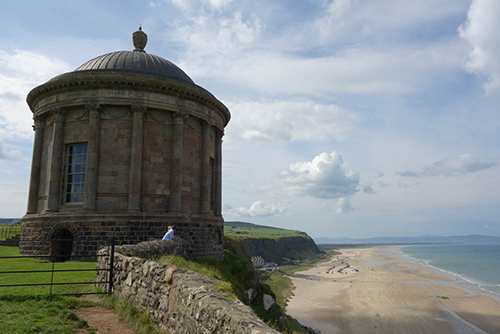
Mussenden Temple
August 29, 2022. Portstewart to Derry/Londonderry, Northern Island.
It was another day of stop-start driving but only after we’d had our morning coffee in Portstewart.
The Dark Hedges are an avenue of beech trees that were originally planted in 1775.
This area is a bit Game of Thrones centric as some of the sites were featured in this iconic series.
Mussenden Temple and Downhill Demesne. Built by Earl Bushop Frederick Hervey in 1786
Much of the building was destroyed by fire in 1851 and then rebuilt in the 1870s.
It only fell into disrepair in the 1940s’
In Londonderry we were staying at another Holiday Inn Express.
For some reason we got given a disabled room again, just like last night in Portstewart.
I’m not complaining, as they are larger than normal rooms and there’s plenty of room to move – with or without a wheelchair.
Dinner was at the Exchange Restaurant and Wine Bar, where I had Bang Bang Chicken and Thea had Duck and Stir Fry and it was all very good.
Again very tasty.
Afterwards a ‘cleanser’ at the Grand Central Bar, which was only 100 years old and young by local standards.
It was a very lively local.

Derry Girls mural
August 30, 2022. Derry/Londonderry, Northern Island.
After breakfast at the hotel, as it was included, we went off to find a coffee.
We had seen a few coffee shops on our brief walk around the area the previous evening.
The Scullery looked interesting, so we went there.
We were well rewarded with a great brew.
As we get deeper into Ireland and listen more to their language, I can’t help but understand how it has influenced the American accent.
There are so many similar inflections and sounds.
There are a lot of US tourists here, which is understandable, considering how many Irish people immigrated to America.
We had booked a Wall Walk with Martin McCrossan walking tours, which included the story of Bloody Sunday.
On January 30, 1972 British soldiers opened fire on a peaceful protest in Derry killing 14 people. Bloody Sunday is considered the worst mass shooting in Northern Irish history.
Derry is a rather sad city with one the highest unemployment in the UK. You can see it the way people look and behave.
Many have nothing to do, so just wander around making a nuisance of themselves.
Way back when we started touring in Berlin, I decided to use my Sony RX100.
It’s small, flexible and easy to carry, day and night.
Well, it has suddenly stopped working.
I guess I will now have to pull out my Olympus, with the three lenses.
Just near where we started our Wall Walk was one mural that really stood out. It was of the cast members of the the Irish sitcom Derry Girls.
It takes up the entire wall of the Badgers Bar and Restaurant and really captured their characters.
The series was created by Lisa McGee in 2018 and ran on Chanel 4. It was inspired by McGee’s own experiences growing up in Derry in the 1980s.
It was mainly shot on location in Derry and makes constant references to the trouble there.
The final of the three part series titles ‘The Agreement’ was set during the signing of the Good Friday Agreement in 1998.
Lunchtime coffee was at Java Cafe, a place recommended by our tour guide, John.
This was a great suggestion and he was a great guide.
He didn’t draw breath in his hour long presentation. Some of which was done as he walked backwards along the city wall.
He was also very positive about the future of the city, which is surprising considering the unemployment rate and its history.
Unlike our guide, Kevin, in Belfast.
But the situation is much grimmer there and he did have a lot of axes to grind.
As suggested by John, we did the Mural Walk and the Guildhall after our tour.
The Mural Walk is a section of Derry where the Bloody Sunday massacre occurred.
There are a a number of murals painted on the side of buildings, depicting, not only the conflict, but a number of the people involved.
The Guildhall is known for its stained glass windows. The ones there now are replicas of the originals that were designed in 1912 and destroyed by an IRA bomb in 1972.
Our last bit of tourism for the day was to walk over the Peace Bridge and back.
Ironically, this bridge was built by the European Union.
There was even a representative of the EU there to open it in 2011.
But then Great Britain was part of the EU back then.
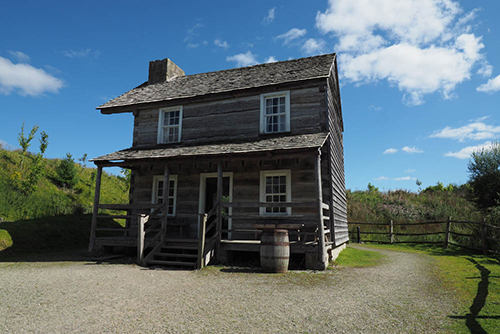
The New World. The Plantation House
August 31, 2022. Derry/Londonderry, Northern Island to Sligo, Ireland.
Derry was a repetitive experience.
We had dinner both nights at the Exchange Restaurant, as well as coffee, both mornings, at The Scullery and of course two breakfasts at our hotel.
Well there wasn’t a lot of choice locally and when you are on a good thing – don’t risk it.
After charging the batteries and setting the time and zone it was back to my large and rather heavy Olympus camera.
Today we were going to try and get an understanding of life in Ireland and a feeling of what drove so many people to emigrate around the world.
We felt the Ulster American Folk Park was the best way to get this knowledge, as it tells the story of three centuries of Irish immigration.
The folk park’s story is divided into three sections, the Old World, The Voyage and The New World. There are 30 exhibit buildings spread over a very well laid out park, that uses the grounds to explain as much as the buildings.
The Voyage exhibit actually reconstructs an old sailing ship and shows what life would have been like travelling the high seas across the Atlantic to North America.
One million people from Ulster emigrated to the USA between 1815 and 1845. Half of them came through British North America, now Canada.
Then in 1845 the Potato Famine struck Ireland and even more left.
Between 1851 and 1911 the population of Ulster fell by 21%, with at least one million people leaving the region.
Immigration destinations now included Australian, New Zealand and Canada, however the US remained the most popular.
That night, before dinner, I had a Lough Gill West Coast IPA at the Riverside Hotel.
It was great.
I was told that the brewery was just up the road, so it was a pity we were only staying one night in Sligo.
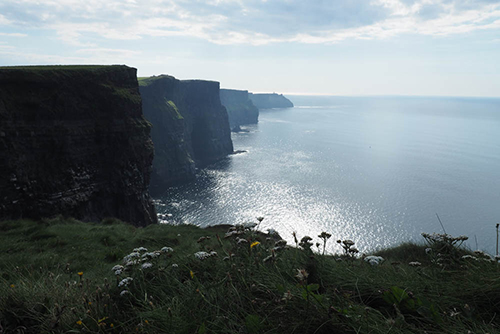
Cliffs of Moher
September 01, 2022. Sligo to Limerick, Ireland.
Breakfast was at the hotel and it was free.
Then coffee was at Ripples, the cafe next door to the Riverside Hotel and right on the river.
After that we had a walk around Galway which is on the River Corrib.
Then lunch for Thea and another coffee for me at the Rooster’s Hatch, in Galway.
We then drove the Wild Atlantic Coast to the Cliffs of Moher, where the view was stunning.
It cost us 10 € a head to park and then walk to this natural wonder. The area was rather over developed, especially considering that it was a view we had come to see.
After that it was back on the road to Limerick.
That night dinner was at the Old Quarter Gastro Pub, which was right next to our hotel, the Old Quarter Townhouse.
Again the food was very tasty.
The weather was balmy enough for us to eat outside but a fire alarm in the adjoining car park forced us to move back in.
They had a very nice Lagunitas IPA on tap, which was not only tasty but cold.
Surprisingly, their glasses were chilling in a fridge. Something I hadn’t seen in a long time.
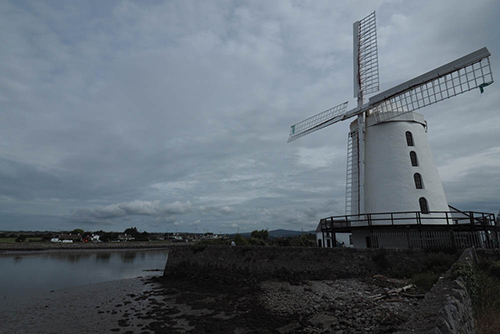
Blennerville Windmill in Tralee (1800)
September 02, 2022. Limerick to Killarney, Ireland.
Yesterday we drove on part of the Wild Atlantic Coast, while today we intend to drive around some of the Ring of Kerry.
The Irish adventure continues.
The weather in Limerick started off foggy, then just got cloudy, as we made our way to Tralee.
In Tralee we had a short stop, for a photo opportunity, at the Blennerville Windmill. This is a fully restored, 21 metre high, stone mill, built in the 1800.
Then it was on to Portmagee for lunch and a quick crossing to Valentia Island.
Then the Kerry Cliffs was our last stop before heading to Killarney, where we were staying in the aptly named, Killarney Court Hotel.
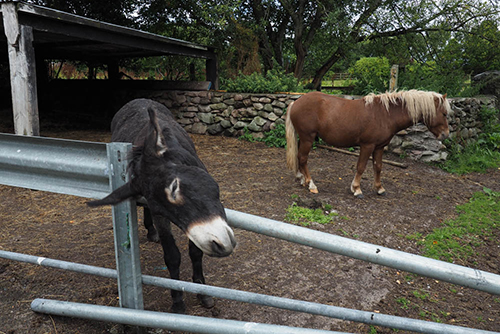
The Kerry Bog Village
September 03, 2022. Killarney to Portmagee, Ireland.
We we were back onto the Ring of Kerry for the first part of our trip back to Portmagee.
The Kerry Bog Village was our adventure for the day.
This is another open-air museum that focuses on the culture and history of Ireland during the 19th Century.
Then we caught the ferry from Reenard Point to Knight’s Town, on Valentia Island, then the drive to a bridge and then crossed to Portmagee.
Lunch and coffee at Knight’s Town Coffee.
Unfortunately the cups were takeaway and not even biodegradable.
We were staying in an AirBnB and cooking for ourselves, which we hadn’t done since Scotland.
Risotto again, as we still had some rice left from the last time we self catered.
It is great to have a home cooked meal every now and then.
The view out of the window, towards Valentia Island, was rather spectacular, which made it even more special – just a pity about the power lines.

Charlie Chaplin in Waterville (By Alan Ryan Hall 1998)
September 04, 2022. Portmagee to Skibbereen, Ireland.
We continued travelling around The Ring of Kerry to Waterville where we came across a statue of Charlie Chaplin and wondered why.
Charlie was very proud of his Irish roots, especially the fact that his great grandmother was an Irish gypsy from Cork.
He first came to Waterville in 1959 with his wife and and their eight children. He continued to visit for the next 10 years.
It was only when ‘McCarthyism’ also known as the ‘Second Red Scare’, with it’s persecution of anyone with a socialist leaning, that he felt unwelcome in Ireland.
That night we were staying at the West Cork Hotel in Skibberereen.

The Chapel (12th Century)
September 05, 2022. Skibbereen to Cashel, Ireland.
We spoke to Hayden last night and the weather in Berlin was a balmy 25°C.
Unfortunately it’s not like that in Skibbereen.
Wet and 15°C (Real feel 11°C)
Apart from driving, and there was a bit of that, we only had one destination for the day.
That was to The Rock of Cashel, a Medieval castle and chapel in Cashel.
The site was a mixture of Roman and Gothic architecture.
For several hundred years, prior to the Norman invasion, The Rock of Cashel was the traditional seat of the Kings of Munster.
It has a remarkable collection of Celtic and Medieval architecture dating back to the 12th and 13th Centuries.
One of the amazing features was the rather bizarre heads staring down at you from the chapel walls.
Rain continued.
The Romans named Ireland, Hibernia, which means ‘Land of Winter’
I now understand why.
We were staying at a B&B in Cashel and the ‘landlord’ suggested going to the Bailey’s Hotel for dinner.
It was there that I had my first Irish Guinness.
What a shame I hadn’t had more, as it was rather good.
Wherever you go in Ireland there is history staring you in the face. It’s the history of oppression, that the Northern Irish have suffered, that really sets the tone.
There is a real difference between Northern Ireland and Eire.
In the north they are still bound to Britain and all that’s associated with Brexit and the issues it has raised.
In Eire, there is optimism, and opportunity. Here they are still part of the EU and employment seems to be buoyant with plenty of staff and customers in the pubs and restaurants.
Flags play a big part in the south as they are proud of their individuality and fly them wherever possible.

The Great Telescope (Built by the 3rd Earl of Rose in 1845)
September 06, 2022. Cashel to Dublin, Ireland.
Being a B&B, breakfast was naturally included.
I have been avoiding full breakfasts, as they are just too much for me to digest in the morning.
Today was different, as there really wasn’t any alternative, so I went for it.
Egg, bacon, sausage, tomato and toast.
I then needed a coffee to help it settle in.
As luck had it, Angels and Demons was just around the corner.
They even provided a small water with our coffee and a Biscotti, not that I needed anything else to eat.
An Americano seems to be the choice of coffee style for a lot of the Irish.
They do like things American.
Again the day was dark, wet and gloomy and we constantly passed through patches of very heavy rain.
We then drove to Birr Castle.
There has been a castle on this site since 1170. In 1628 Sir Lawrence Parsons (Earl of Rosse) was granted Birr Castle and 1,277 acres (5.2 km2).
The castle is often referred to as the Home of science in Ireland.
The Parsons family were involved in the sciences of astronomy, photography and engineering.
The family still live in the castle, so the residential area is off-bounds. However there is still a lot to see, including the gardens, science museum and a cafe.
Within the house are the remains of the Parsons Steam Turbine, which is similar to the ones that powered the Titanic. Then in the grounds is the Great Telescope, built by the 3rd Earl of Rosse in 1845.
For decades this was the largest reflecting telescope in the world and a forerunner to today’s modern radio telescopes.
Once we settled into our accommodation in Dublin, the Maldron Hotel, we started to look for a dinner venue.
We settled on the Ginger Man, a local pub that was about a 15 minute walk away.
This was a typical local, with friendly staff and a great atmosphere.
They also had a home brand IPA, which was very refreshing.
Our waitress was fantastic. She was trained as a pathologist but also worked part time in the bar.
However her real passion was to become a Garda, or policewoman.
What you wear may define where you come from.
In Ireland on a day of 19°C you might find people wearing anything from a T-Shirt and shorts to jumpers, long pants and even heavy jackets.
Our theory is, if you grow up in a climate like Ireland, you are so used to cold weather and a 19°C day seems really warm, so you dress to accordingly.
September 07, 2022. Dublin, Ireland.
It was still drizzling so we had a later than usual start to the day.
One of the consequences of my small camera breaking down, is that I am now lugging around the full size camera, with three lenses.
This weights over 2 kilograms rather than 400 grams.
My back hasn’t been used to carrying all this extra weight and has decided to play up.
Today I will only use my iPhone.
The hotel was great but not in a good position for things like eating.
Everything was a bit of a walk.
We did find Insomnia for breakfast. It’s one of a chain and the coffee was good.
After breakfast we visited EPIC, The Irish Emigration Museum. This is a great exhibition a wonderful space that was originally built in 1820.
It covered all aspects of Irish emigration around the world.
On entry we were presented with a Museum Passport, this was a great idea.
It was both a guide to the museum and a reference to what you had seen or still needed to see.
As you wandered around, the very extensive site, you would stamp ‘your passport’ once you had finished an exhibit, this way you didn’t miss a thing.
Australia was well represented but the Americas dominated. Which is understandable considering how many went there.
Not only were the hardships highlighted but so were all the positives. Especially the contribution Irish Emigrants have made to the world and the countries they settled in.
Ireland joined the EU in 1973, which was the same time as the United Kingdom.
Ireland was the first country to legalise same sex marriage in 2015.
We found Brick Alley Cafe for lunch and another coffee. This was in the old city area.
We then walked back to the hotel, where we decided to stay in for dinner.
Better than more walking, my back decided.
England and Wales.
September 08, 2022. Dublin, Ireland to Manchester, England.
Early start, as we were getting the 9am ferry back to Liverpool. We needed to be at the port at least 90 minutes before departure back to England and then Wales.
The ship was the Norstrom, a sister ship to the Norbay, which we came over on.
Fortunately the staff had forgotten to turn on the TVs in the lounge area. Which meant we weren’t forced to watch Coronation Street reruns.
This time we weren’t offered the free cabin, which was good, as we really didn’t use it on the trip over.
No sooner had we arrived in Britain, than we got the news the the Queen had died.
The next few days will be interesting ones.
It was just over an hour to Manchester, most of it on Motorways.
Once we found our Airbnb it was off the nearest supermarket for provisions.
After we had settled into our new home (well for at least four days) we realised something was weird.
It seemed as though the owners had just walked out, moments before we arrived.
The wardrobes were full of clothes while the drawers still contained many ‘intimate’ items.
There were half empty containers, with a variety of washing, cleaning and body care products all over the place.
And the fridge was full of half consumed food.
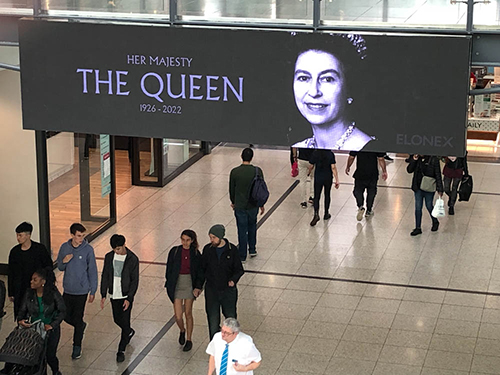
Digital posters of The Queen (1926-2022)
September 09, 2022. Manchester, England.
This morning we woke to find a delivery of food on our doorstep.
This owner really hadn’t prepared for Airbnb guests.
We caught the tram from our accommodation in Chorlton to St Peter’s Square, in the heart of Manchester.
It was incredible efficient with a service every three minutes.
No sooner had we arrived in the city and we having a coffee than the rain came down.
Well it was Manchester.
Ghost chasing for Thea and a haircut for me were the orders of the day.
Thea had been waiting to get into the archives of the Manchester Central Library to do some research on the 1921 census.
Unfortunately, after hours of trolling though the files, she came up a blank, especially on the Stainsby side.
The death of Queen Elizabeth II yesterday was obviously top of the news.
Electronic posters had her image and all the flags were at half mast.
We spent some time wandering the streets of Manchester, which we hardly recognised from 1973, when we lived here.
A defining point in Manchester’s history was the 1996 IRA bombing in the centre of the city.
On Saturday June 15th the Provisional Irish Republican Army (IRA) detonated a 1,500 kilogram lorry bomb in Corporation street, which is right in the centre.
This was the largest bomb to be detonated in Britain since WWII.
It caused untold damage to the city and the estimated repair bill was £700 million or more than £1.4 billion in today’s money.
So much had to be rebuilt, that we really didn’t recognise the Manchester we knew back then.
The evening meal was at Sam’s Chop House, a very English pub in the heart of Manchester.
We were there to catch up with Kay and Paul.
Kay was 11 years old when we first moved to Manchester in 1973. Back then we were staying with her parents, who were related to people I worked with in Australia.
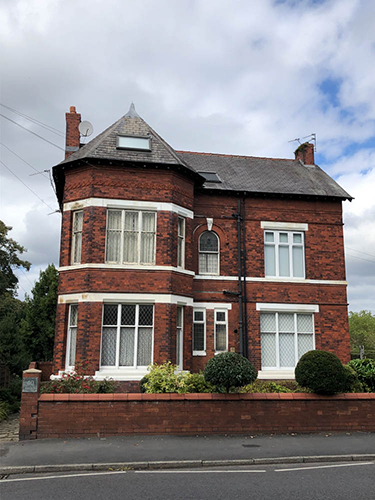
40 Edgeley Road Stockport (Our old home in Manchester)
September 10, 2022. Manchester, England.
After doing a bit of work and forward planning we headed to Stockport, our old haunt from 50 years ago.
Everything had changed, except where we lived at 40 Edgeley Road. That looked exactly as we had left it.
Even the Greyhound, the pub we used to frequent, was gone.
Then it was another evening of home cooking, in this rather strange Airbnb.
September 11, 2022. Manchester, England.
I had more work to do, so the morning was spent on that.
We had planned to go to The Snake Pass and have lunch at the Snake Inn.
This was a favourite Sunday drive when we lived in Manchester.
Unfortunately The Snake Pass was closed, as recent bad weather had made it unsafe to drive through.
We really weren’t having much luck with our ‘Down Memory Lane’ experiences.
It was the Wheatsheaf Hotel, in Glossop, for lunch and a surprisingly good Double Espresso.
Our waiter was a very tall, slight lad, who was obviously learning the trade.
He was so lanky that he could barely fit under the door.
It was a very dog friendly place with the main bar area full of pooches and their people.
After lunch we did go for a drive through parts of the Snake Pass and it was as beautiful as we remembered it.
Some things don’t change.
Private flag polls in England are rare, especially compared to Northern and Southern Ireland.
I believe this doesn’t show a lack of patriotism, rather a belief that there is no need to express it so obviously, like they do in the States.
The effects of the Covid pandemic and Brexit are everywhere in this part of England.
Shops are shut, while cafes and restaurants are either shut or restricting their hours of operation.
Most of this can be attributed to the fact that there is no labour to fill these places.
Unlike Eire, where everything is open. This is because they have staff coming from the EU.
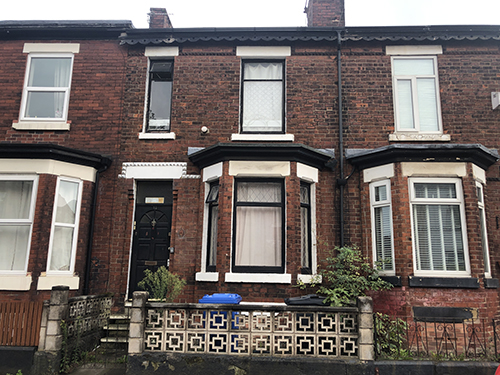
14 Milford Street, Brownie’s second homes in Manchester
September 12, 2022. Manchester, England to Aberystwyth, Wales.
I was working again, as I received a barrage of briefs overnight.
Then, after I’d finished, it was off to find a coffee.
I needed it.
Not far from where we were staying was North Star, a very trendy coffee shop, and we got a park right out the front, so things were working in our favour.
However the coffee was crap.
Surprisingly, later in the day when we stopped at Dyffryn Cafe, a quaint country roadside stop on the A458 in Welshpool, the coffee was much better.
I think the barista from there could easily get a good job in Manchester.
Before we left Manchester we did a bit more ghost chasing, this time looking to find where my mother was born and grew up.
Her first home was in 28 Edmund Street, while here second home, where she lived until moving to Australia, was in Milford Street.
It was great to see that both these houses were still standing.
We are now in Wales and back to flags, but this one features a red dragon.
There must be some desire here to be separated from the Union Jack.
Before we checked into our hotel, the Aberystwyth Park Lodge, which was a way out of town, we had a drive around Aberystwyth.
It looked like a very interesting sea side town and there seemed to be plenty of ‘free’ on street parking, something we weren’t used to.
We will certainly return tomorrow to explore.
Over dinner, at the Park Inn, we had our first sunset for some time.
Let’s hope tomorrow will be ‘A sailor’s delight’.
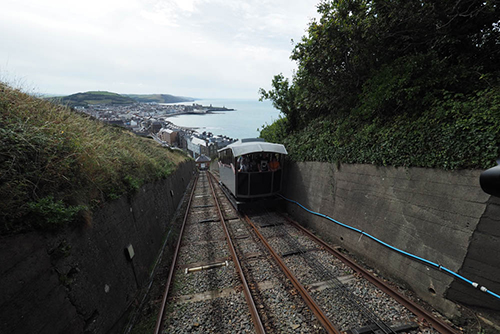
View from the Rheilffordd Y Graig Cliff Railway (Aberystwyth Cliff Railway)
September 13, 2022. Aberystwyth, Wales.
This morning I read about the Queen’s body being taken down the Royal Mile in Edinburgh.
It was only a few weeks ago that we took the same path.
This was the her last stop before she leaves Scotland for good. The connection the Queen had to Scotland was more than affection, it was in her blood.
The weather did look promising and there was even some blue sky, so we headed for a day in town.
We even found a free parking spot on the front, that wasn’t far from The Cabin, a little coffee shop.
The coffee was ok.
Next was the Rheilffordd Y Graig Cliff Railway and again there was free parking near the entrance.
The views of Aberystwyth, both ascending and at the top, were excellent.
Afterwards we found some more free parking on the town front. We then went wandering around Aberystwyth Castle, the University and Saint Michaels Church area.
The Queens death has had it’s ramifications on us.
We were due to return our rental car on September 19th. Now this is the day that the Queen will be buried and has been declared a public holiday in Great Britain.
We are currently negotiating a solution with Enterprise.
We had lunch at Ultra Comida, a Spanish Tapas bar and delicatessen.
Yes, Spanish food in Wales.
We shared a plate of Crab Croquetas and they were very authentic.
We were suddenly back in Barcelona.
The rest of the afternoon we just wandered around the old town area.
I must admit that Aberystwyth isn’t as tacky as many holiday places we have visited, especially in the south of England.
We had booked into the Glengower Hotel for dinner and caught a taxi into town.
The taxi cost £6.50 and in the hotel there was a poster for the Titanic, advertising sailings from Liverpool to New York for £7.
Go figure inflation.
I love the Welsh place names like Aberystwyth.
I believe that to be able to pronounce the names like Aberystwyth, Caernarfon, Rhosbodrual and Bontnewydd you need to be either a Celtic speaker or born in Wales.
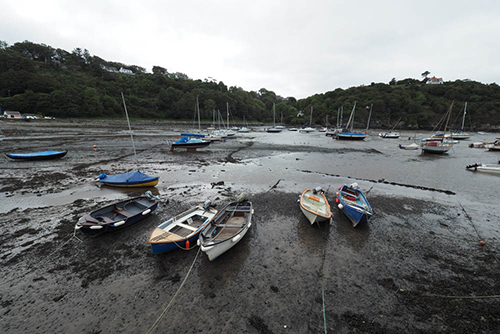
Fishguard Bay at low tide
September 14, 2022. Aberystwyth to Fishguard, Wales.
It was Mc Gowans Vintage Cafe in Aberaeron for our morning coffee.
The sign out the front boasted Barista Coffee. To our surprise the ‘Barista’ told us this was the first espresso she had ever prepared.
What do they drink then?
Even though we had a couple of stops along the way, we still arrived in Fishguard too early to check in. So we wandered down to the port area, known as Lower Fishguard and found the Yacht Club Cafe for lunch.
It was crowded and they had run out of their signature dish ‘Crab Sandwiches’.
Thea had to do a rethink.
We then had a short walk around Fishguard Bay. It was low tide and many of the yachts were high and dry.
It was then back to the JT Abergwaun Hotel in Fishguard to check-in. Thea couldn’t find anyone to help her but finally located the cleaning lady, who gave us her the key and told us where the car park was located.
We then found out that the hotel restaurant was closed tonight, as the owners were away.
The in house restaurant was one of the main reasons for booking the place. However she did assure us that there were plenty of other good dining options available.
And sure enough, just over the road from our hotel was the Royal Oak, where we ended up.
Luckily we got there early at 6:45pm, because by 7pm the place was filling up and by 8pm it was full.
And it was only a Wednesday.
The food was different and very tasty.
Wales has similarities with Ireland, in that their food has flavour – compared to the UK that is.

Saint Davids Cathedral (Established in the middle of the 6th Century)
September 15, 2022. Fishguard, Wales.
There was no breakfast in the pub so we wandered around to Mannings. This was a cafe, come deli, come greengrocer, come bottle shop, just around the corner.
We then went for a drive and stopped in St David, which is in the very west of Wales and also made a few other stops along the way.
In St David we bought a Red Dragon, soft toy, for Brianna. He would later be named ‘Taff’
Taff or Taffy is slang for a Welshman, so we felt it fitting that it should be the name of Brianna’s Welsh dragon.
St Davids Cathedral is situated, not surprisingly, in St Davids, which is the smallest city in Britain.
The cathedral was started in 1181 but unfortunately was beset by problems. The tower collapsed in 1220 and it suffered more damage in 1247 and 1248 from earthquakes.
Some places we just didn’t stop at, as they wanted us to pay £4 for the pleasure of parking there.
Not worth it, if all you want is to look at is the view for five minutes.
We did stop in Haverfordwest and grabbed a snack in The Welsh Bakery.
It was then back to Fishguard, where you can park near our hotel for 24 hours and it only cost us £2.
I believe the money grabbing in some of these places, though their parking set up, might be discouraging visitors.
Some of the fees might go to the council but it’s the local traders that would be missing out.
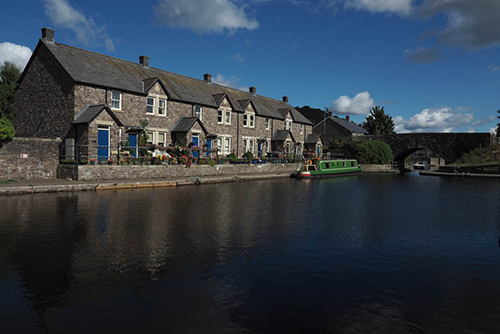
Brecon Canal
September 16, 2022. Fishguard to Cardiff, Wales.
It was Cresswell’s Café and Bar for breakfast.
This was nowhere near as classy as where we were yesterday.
In fact it was bog ordinary.
Our toasted sandwiches came with corn chips, undressed salad and, of all things, a small bowl of coleslaw.
Once we had packed and checked out we then headed off towards Cardiff.
The road trip took us via Brecon, a quaint little country town.
There we had lunch at Coffee#1 and again got a street park, this time out the front.
I do like Wales.
This is a chain cafe, that I’ve never heard of. The coffee was great and the layout comfortable and eclectic.
In Brecon we got a matching postcard to go with Brianna’s Dragon Taff.
It was then a relatively easy drive to Cardiff.
We were staying at the Holiday Inn Express – Cardiff Bay.
And again we got the disabled room.
This is becoming a habit or, they know something we don’t.
Holiday Inn Express has become a favourite for us, as you know what you are going to get.
The rooms are similarly styled, so you know where things are. The breakfast is always included and the menu is identical, so you just go and get your favourite.
There is always a bar and off street parking.
It does take the stress out of travelling when you know what to expect.
We had a choice for dinner, either we walked down to the wharf, or in the other direction into the town centre.
We chose the wharf and had a meal at the Cardiff Bay Tavern. It was about as ‘salubrious’ as where we were for breakfast.
Both were rather feral.
Our walk to the wharf was along the Bute East Dock and there were about four fisherman set up with their lines in the water. They were also well entrenched, with tents and trolleys for all their equipment.
They looked very permanent.
This was proven when we walked back after dinner. The tents were still there and no lines were in the water.

The Animal Wall at Cardiff Castle (1880s’)
September 17, 2022. Cardiff, Wales.
Most hotel lifts on our trip, so far, have had a female voice.
And most of those voices had a very strong royal English accent.
I used to call them Elizabeth.
The Holiday Inn in Cardiff had a male voice and again the accent was ‘toffy’. Will Charles now be operating the lifts in Britain?
Today we will explore the city of Cardiff and as it’s walking distance from our hotel, it will mostly be on foot.
Our first stop was Uncommon Ground Roastery in the Royal Arcade.
I have usually found that if a coffee shop also roasts their own beans, the quality is good and they know how to prepare it.
This was no exception.
There were many similarities to the arcade of the same name in Melbourne.
The one thing we have noticed in the UK, is the propensity for local councils to develop walking streets in many of the towns.
They are a great way of allowing easy access to shops and facilities. They also stop the shopping areas getting blocked, either with parked cars or people looking to park their cars.
Next was Cardiff Castle which was first settled by the Romans in the 1st Century AD. The current castle was built in the 11th Century AD. It was closed as they were mourning the death of the Queen.
We then caught a ferry, Princess Katharine, back to Cardiff Bay. This was from the Taff River, next to Bute Park.
By doing this we didn’t have to walk back through town and we got a great river view on the way.
Lunch was at Mermaid Quay at CoffiCo.
Tom Jones, Shirley Bassey and Roald Dahl (1916-1990) are all Welsh and they are certainly celebrated here in Cardiff.
In fact Roald Dahl has his own plaza.
We had a ‘very’ early dinner at Signor Valentino, a rather good Italian restaurant in the Cardiff Bay area.
Certainly much better than the previous night.
On the way home we checked out the fisher/campers on the Boot East Dock.
They were still there.
We asked at the hotel about them and were told that they were legitimate and able to stay there for up to a week.
The only condition, it was ‘catch-and-release’.
How strange.
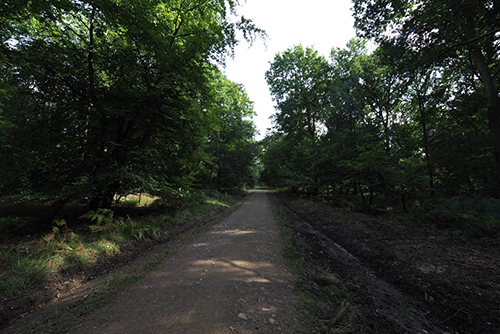
Sculpture Walk in Forest of Dean
September 18, 2022. Cardiff, Wales to Bristol, England.
We have been singing the praises of the Holiday Inn Express.
We may have been a little premature, if Bristol was anything to go by.
As usual the rooms were a good standard, staff great and the breakfast was included. However the quality was just not the same.
On our first day, they had run out of fruit at breakfast and our showers wouldn’t drain very well.
On the second day, the bathroom flooded because the water couldn’t escape and then the lift broke down.
Luckily we were on the first floor, so not too far to lug the cases.
Today we are leaving Wales and heading back into England. We will have a one night stand in Bristol, before returning to Germany.
Parc Pantry for coffee, which was out of Cardiff, on our way to the Forest of Dean.
This was the local ‘trendy’ spot, well it must have been, as they served Avocado on Toast. Over the last few days in Wales we have been listening to some of the local heroes.
Tom Jones and Shirley Bassey were top of our play list.
It’s great to have a soundtrack to our drive.
Once we got to the Forest of Dean, we did part of the Sculpture Walk.
This was totally underwhelming.
Then it was a relatively easy drive into Bristol. That was until we decided to get off the motorway to get petrol.
The exit lane was at a standstill, as were all the roads around the servo.
After eventually getting the car filled up, we then had difficulty finding the hotel.
The GPS kept sending us around an imaginary roundabout.
We finally made it and parked the car and cleaned it out. It will stay there until Enterprise come and collect it on Tuesday.
The Vauxhall Crossland had been a good rental and served us well thought England, Scotland, Ireland and Wales, covering 3,956 miles (6,367 kilometres)
As Monday is now a holiday, we arranged to leave the car at the hotel, as all the rental car company offices were closed for ‘The Funeral’.
Luckily there was a Brew Dog, only minutes down the road from our hotel.
By the time we got there I certainly needed a drink.
And there is no better, than a pint of Brew Dog Hazy Jane NEIPA.
Dinner was at The Old Fishmarket, which was a pub in the old fish market.
The food was tasty and there was a jazz band playing.
Very pleasant.
I must admit, we did venture back, across the road to Brew Dog for a cleanser.
September 19, 2022. Bristol, England to Berlin, Germany.
Our trip had taken us full circle, from Bristol to Bristol and today we were returning to Berlin.
However the fight wasn’t until late afternoon, so we had a bit of time to kill.
We did indulge ourselves and watch part of QEII funeral on the hotel TV.
Only the Poms know how to do pomp and pageantry that well.
It was only afterwards that we discovered that over four billion people watched the event.
We then needed to finalise leaving the rental card at the hotel.
The girl we spoke to at reception wasn’t that happy about it, emphasising that the car wasn’t the hotel’s responsibility – especially if something happened to it.
After negotiations and signing our lives away, we walked into Bristol and found somewhere to get lunch.
There wasn’t a lot of choice as most places were closed due to the funeral.
We found Aqua, a restaurant on the river. Good food but expensive.
Well it could afford to be, with the limited choice available.
It was then back to the hotel to retrieve our bags and head to the airport.
The hotel ordered us a taxi to the airport, which was great, except when it came time to pay.
He didn’t have a credit card machine and we had to go online and pay by card.
What a pain.
We had been advised by Easyjet to get there early as they were expect crowds.
They were right, as it took us an hour and a quarter to get through security.
The airport was understaffed due to the public holiday.
It is certainly much easier to travel around one country, with no borders or security checks.
The flight was two hours and, as usual with Easyjet, well organised.
Once we landed in Berlin there was another on-ground delay, this time with passport control.
There were only three booths open for non EU passport holders and with the majority of the passengers non EU residents, there was a long line. They certainly couldn’t use the Queen’s funeral as an excuse.
We finally got through and made it to our hotel.
With the time change it was now 10pm.
There was a changeovers of staff happening, just as we arrived. Once we booked in we had a nightcap at the bar.
It was the end of a long day and an end to our adventure through England, Scotland, Ireland and Wales.





















































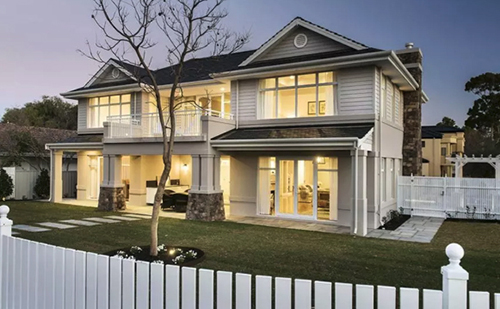
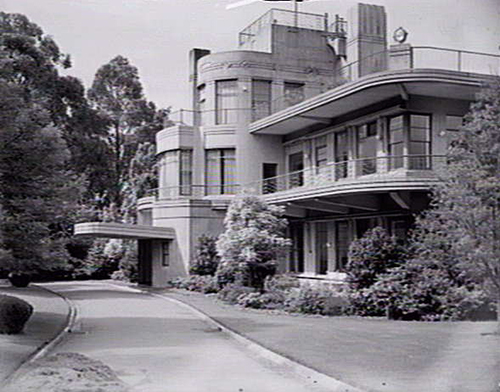
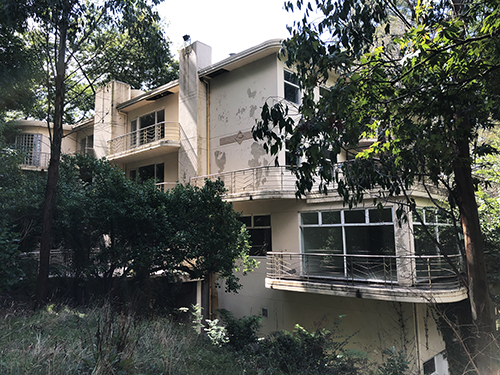
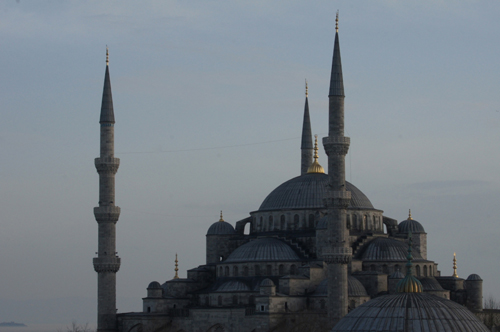
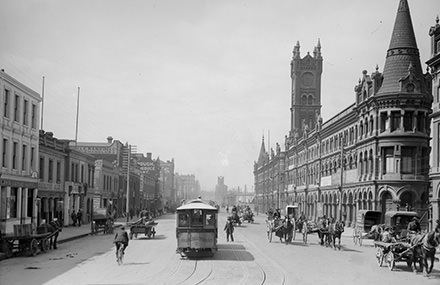

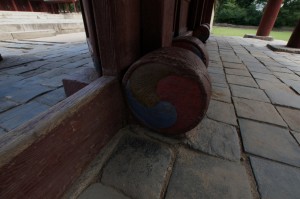










Summer of 2024.Part 2: Spain, Switzerland, France and Italy.
Monday, December 23rd, 2024Brianna’s concert at Paco Suca infant school, Granada ES
The Alhambra from Paseo de los Tristes (way of the lost), Granada ES
H&A’s from Thursday June 13 to Thursday June 20, 2024.
We will be spending the next few days with Hayden, Andrea and Brianna and playing them as they come.
Basically because we don’t have anything planned.
But first we had to organise some shopping which were mainly electrical goods.
I needed a new Power Bank, as my current one has all but died and badly overheats.
Not a good sign.
Thea needed a new USB, for storage and a Memory Card for her camera.
As Friday was cleaning day in the house, we had to be out by 11:00hrs.
Before shopping we had a walk around Granada.
Our first impressions of Granada, was how different it was, compared to Italy and Greece.
Especially when it came to the quality of life for it people.
Granada was clean, orderly and relaxed and the average person was better dressed.
There weren’t the uninhabited buildings, graffiti and abundance of street people that we saw in those two countries.
We had coffee at Kona, Hayden’s favourite. He not only has a coffee here but also buys his ground coffee from the same place.
We then headed to El Corte Inglés to look for what we needed.
The choice was limited and expensive so we contacted Hayden for some local advice.
We finished up at Wayland Computers.
Here we managed to get everything we needed and it was much, much cheaper than El Corte Inglés.
Out next trip is to Switzerland, on Thursday, to catch up with Denis and Martine.
So planning will be needed for that.
But before that we had to attend Brianna’s end of year concert at her school, Patosuca.
It was a bit like her judo night, a shambles but a lot of fun.
Brianna was suffering the ‘End of year blues’ and this was evident in her behaviour.
She realised that the school term was at an end and now she would be in a form of day care.
This was made harder for her by the fact that her normal teacher, a favourite, wasn’t going to be looking after her.
She would be on leave.
Now Brianna would have to get used to a new person.
Our last few days was spent getting ready for our next adventure.
We needed to consider what we packed, as we were heading to Switzerland tomorrow and the weather would be much cooler there.
Having recently walked into Granada and back, when the temperature was in the mid 30°Cs, we now decided to stay inside.
This was a silly idea, as the temperature had dropped to the mid 20°Cs.
Tomorrow would be an early start, as our plane was due to depart at 09:25 hrs.
Thursday June 20, 2024.
Granada, Spain, to Geneva, via Barcelona and then to Lausanne and finally Arnex-sur-Orbe, Switzerland.
We got to the airport earlier than expected, due to a very efficient taxi driver.
Thea went looking for a stamp, as she had a post card to send to Aida in Australia, this one was from Brianna.
I’m afraid the postal system is dead. Not just in Australia but around the world.
We couldn’t get a stamp, let alone find a Post Office in Greece now it’s the same in Spain.
The only country, we have visited on this trip, that seem to have solved the post card issue is Italy.
There postage for post cards is handled by a private company, who provide their own stamps and letter boxes.
We were on another Vueling flight to Barcelona and we had seats 4A and 4B, very close to the front.
This is good in one respect as you get to disembark quickly but it has its issues.
So many people, who are sitting in the rear of the plane, put their cabin luggage in the front.
This left no space for our luggage.
Vueling have done so well in organising the disembarkation, by only allowing five rows at a time to leave.
Now they need to address the way people stow their luggage.
On our previous flight I discovery that the Maps App works while you are airborne, so long as you are over land.
This is great to see your flight, especially considering that airlines like Vueling don’t have any onboard flight monitoring.
The next stage of our trip to see Denis and Martine was a flight from Barcelona to Geneva, then a train to Lausanne. Here we will meet Denis and then travel, again by train, to Arnex sur Orbe.
What a luxury to have a train station at an airport.
It’s a shame that successive governments, since the 1960’s, have failed to pull their fingers from their arses and make it happen in Melbourne.
The Morel home in Arnex-sur-Orbe CH with the Barclay’s
Friday June 21, 2024.
Arnex-sur-Orbe, with a side trip to Lusanne, Switzerland.
Having had a latish night chatting we had a late start to the day. Also the clouds were threatening rain.
Coffee was at the local corner store, that’s also a supermarket and Post Office.
Yes the Swiss still have a postal system.
Then we had a stroll around the village and past Marine’s old house. This is a beautiful old building that’s been home to the Morel’s since 1604.
As the weather had turned a bit nasty, it was decided to visit Platform 10.
This is an art gallery right opposite the Lausanne railway station.
It consists of a series of contemporary buildings that hold a variety of exhibits.
The current theme was Surrealism.
The exhibition had art from the early days of the movement, in the 1920s’, to more contemporary works.
In the main gallery there were Surrealist paintings, drawings, photography, sculptures, print making and film.
We then moved to Photo Ellis, a gallery devoted to photography.
The main feature there was an exhibition of the works of Man Ray (1890 – 1976).
Born Emmanuel Radnitzky, Man Ray was an American artist and a significant contributor to the Dada and Surrealist movements.
He spent most of his life in Paris and considered himself as primarily a painter, however his photo skills were also highly regarded.
Arnex’s Festival of the Quarter, Arnex-sur-Orbe CH
Saturday June 22, 2024.
Arnex-sur-Orbe, Switzerland.
Today was Arnex’s Festival of the Quarter.
At the start of Summer, each part of the town, have a neighbourhood get together.
Just two doors up from Denis and Martin’s place is a barn that has been converted into a reception venue and the owner opened it up for this gathering.
People bring a plate of food and the local wine makers provide the booze.
There is a small fee to pay but it’s very reasonable.
It’s a great opportunity for everyone in the area to congregate and catch up.
Of course we missed out on 98% of the conversations, as they were in French.
But there were a few people who had enough English to chat to.
It was a very interesting event and gave us a great opportunity to get involved in the lives of Swiss village people.
It wasn’t a great day, weather wise, so spending it indoors was a bonus.
Around Lac d’Annecy FR
Sunday June 23, 2024.
Arnex-sur-Orbe, Switzerland. to Annecy, France.
Heading to France today, as Denis and Martine had arranged a few days in the French town of Annecy.
To get there, Denis took us on a scenic route that passed Les Ponts de La Caille Charles Albert Bridge and the Les Usses Gorge.
Once we arrived in Annecy we had lunch at La Cuisine des Amis. This is a very traditional restaurant right on the main street of the old town.
In Annecy, we struck the tourists again. Which is not surprising, as this beautiful alpine town, in southeastern France, is where Lake Annecy feeds into the Thiou River.
There was a bit of a muck up getting the keys to our Airbnb, as we couldn’t find the ‘Lock box’, that was strapped to a near by fence.
Once we found our Airbnb and settled in, we again concluded, that the their standards are far less than they were a few years ago.
Businesses have taken over their running and they are never tested to see if they work.
It was a Sunday when we arrived, so most places were shut.
We did find L’Authentic for dinner and then, much to my delight, Captain Pub, for a nightcap. This is a very funky venue in the old part of town.
Craft Beer is alive and thriving in Annecy and thanks to my daughter in law, Steph, I was alerted to it.
Cold bottled craft beer was available in small street stalls and many restaurants, while Caption Pub served a big range of excellent draught beers.
At Captain Pub I showed my interest in beer mats and came away with half a dozen of them.
The last part of the night was spent working, as I been sent an unexpected job late in the day that was urgent.
Monument national à la Résistance des Glières (Monument to the Resistance fighters) 1973, Plateau des Gilères FR
Monday June 24, 2024.
Annecy, France.
Breakfast was at the Airbnb as Denis and Martine had brought all we needed from home.
We then headed off to the Plateau des Glières.
During the Second World war this area was an important site for the French Resistance.
In 1944 the British dropped arms for the local fighters in the area. It was then used as a base of operations against the German rear guard, while awaiting the allied landing.
While we were at the Plateau des Glières we had coffee at Auberge des Glières with a wonderful view of the Alps, cows and fir trees.
The Olympic flame came through the area yesterday. It was on the way to Paris, in preparation for the forth coming Olympic Games
In the valley is a monument to the Resistance fighters.
One of the two leaders in this area was Tom Morel (1915 – 1944), possibly a relative of Martine’s family.
He was killed in action after a commando raid.
We had a picnic lunch lunch overlooking the Resistance Monument, which was very fitting.
Then it was back to Annecy and a pre dinner drink at Captain Pub.
Dinner was at Le Chalet, on the Le Thiou River and rather good it was as well
So far it’s been the trip of elevators. Our Airbnb had one and it was rather slow and very small.
We were on the sixth floor of the building and it seemed to take forever, when we needed to make an ascent or decent.
A boat tour of the ‘Savoie’ on Lake Annecy. Pity the commentry was just French. Annecy FR
Tuesday June 25, 2024.
Annecy, France.
After breakfast we went to visit the street market, that was very close to our Airbnb.
But before that we dropped in for a coffee at the aptly named ‘Coffee Shop’.
This was a skiing based establishment with seats made from skis and even a Tele Cabin was used as a coffee booth.
We were eating in tonight, so went shopping for dinner at the market
The next task was buying train tickets from Annecy to Geneva, which was part of our trip to Genova in Italy.
What a disaster.
At the railway station we waited 25 minutes in a queue to get to speak to a staff member.
There were six counters but only two were open.
Once we finally did speak to someone, we were told that you could only book your seat for the train three hours before departure.
But she couldn’t do it, as it had to be done via a machine in the foyer or online.
Thea practiced for another 25 minutes on the machine and got nowhere.
It was decided to try the online option.
That was done later in the evening and turned out to be just as much of a stuff up.
How anyone travels by train in France is a miracle.
Finally, with the help of Martine, Thea booked the tickets on Swiss Rail.
Trust the Swiss to get it right.
The weather was threatening for tomorrow, so we decided to do the lake cruise that afternoon, while it was still ok.
It was overcast but warm.
So warm in fact that I had to change into shorts, while we were back at the Airbnb for lunch.
This was the first time since we had left Granada.
When we arrived at the wharf, the one hour cruise was booked out, so we were forced to take the one that lasted one and a half hours.
The commentary was obviously informative and rather amusing, judging by the audience’s reaction and laughter.
Pity it was only in French.
The change in weather was evident by the growing cloud cover and it got darker and darker.
Which was not great for the snaps.
After the cruise Denis, Martine and Thea had an ice cream and then we returned to Captain Pub.
This is becoming a habit.
Again I had their draught, Brooklyn Pulp Art, IPA.
And again it didn’t disappoint.
Then the rain came down and the downpour drove everyone into the pub.
It was suddenly crowded.
Captain Pub is a traditional Irish pub, in the old part of Annecy, that’s been operation for over 15 years.
We were eating in the Airbnb tonight, as we had purchased everything at the market.
This gave us a real opportunity to test just how usable the apartment was.
It failed dismally.
No frying pan for our sausage, no lifters to handle them and very little implements to serve the meal.
I must admit, the idea of Airbnb was a good one when it started but now they are failing on all levels.
You used to hire a place that was lived in and therefore practical. Now they are run purely for profit and no one ever tests their usability.
Wandering around the canals of Annecy FR
Wednesday June 26, 2024.
Annecy, France.
It was our last day in Annecy with Denis and Martine.
After a coffee at Brasserie du Théâtre, which was the best so far, we went our own separate ways. We returned and spent time wandering around the old town area.
This was also our last photo opportunity, as we were off very early tomorrow, heading to Genova.
Lunch was back at our rooms, as there was food that needed to be finished before we left.
In the afternoon we visited Musée-Château d’Annecy. The Château was originally built in the 12th Century and then rebuilt in the 16th Century.
It was then bought by the town and turned into a museum in 1957.
Within it there is a mixture of exhibits, from the Middle Ages to Contemporary. There was also a temporary exhibition of ancient Peruvian artefacts.
The rain was threatening, so we returned to Captain Pub – again.
The midges were also there again, hovering just outside.
Dinner at Brasserie du Théâtre, where we had our morning coffee.
When we got home I had a bit more work to do but it didn’t keep me up that late. Which was good considering we had to be on a train at 6:45am the next morning.
Bus stop between Geneva CH and Milan IT
Thursday June 27, 2024.
Annecy, France to Genova, Italy via Geneva and Milan.
As planned we were up very early and on the train to Geneva at 6:45am.
At one and a half hours, it was the shortest trip of the day.
Our breakfast, at the station, cost Ch27 ($45) and a pee cost Ch1.50 ($2.50)
Switzerland is bloody expensive
Due to works on the Alpine tunnel we were forced to get a bus to Milan, not the train, which would have been easier and shorter.
On the bus we had our choice of seats. It was a big, double decker, bugger and relatively comfortable.
Which was good as we were here for about 6 hours.
It also had WiFi, which was good as I had a bit more work to do.
After the bus, we then had to get a train in Milan, which would be another 2 hours of sitting.
Our bus was late coming into Milan, due to a motorway accident, so we missed the connection for the train to Genova.
There was only a 30 minute changeover so missing it was very much on the cards.
We had to queue up at the Trenitalia counter and the line was out the door.
This is going to be a very long day.
Dinner was now at the railway station in Milan and not in the streets of Genova, as planned.
We finally checked into our hotel, The Best Western Metropoli, and went for a walk.
We were both buggered from the early start and sitting on our bums all day so we got an early night.
Luckily we were in Genova for three nights, so had some time to explore.
Palazzo Podestà (16th Century), Via Garibaldi (Via Strada Nuovo), Genova IT
Friday June 28, 2024.
Genova, Italy.
Genova is an important city from Thea’s past.
She worked here at Marconi in 1972, not long before she met Denis and me.
Just being in Genova again brought back so many memories for her.
This trip is certainly turning out to be an adventure into our past as well as the present day.
Our accommodation, the Best Western Hotel Metropoli, was very good. It was central to all things and well serviced.
There was even a good coffee shop and breakfast spot right under the hotel.
To get a great view of the city we took the Castelletto Levante. This lift, built in 1910, connects the town to the hills surrounding Genova.
Genova is a port city and capital of the Liguria region of Italy. Being a port city it has played an important role in maritime trade over the centuries.
It is one of the oldest cities in the world, having been inhabited since the fifth or fourth millennium BC.
Dogs are everywhere and many of them are larger than you would expect, considering that most of them live in the confined space of an apartments. And most of them are totally under control and well exercised. Plus, there is less poo on the streets than you might find back home.
Bravo Italy – woof.
The main form of transport around the city was by bus. However most of them were diesel, even thought there were cables for electric driven trolley busses everywhere.
I only saw one fully electric bus, that wasn’t a trolley but I didn’t see many of those either.
In the afternoon we took a Metro ride and then a walk to the Lanterna. This lighthouse was constructed in 1128 with the oil lamp first being lit in 1326.
It is the main light serving the Port of Genova.
The lighthouse tower is a landmark and can be seen from across the city.
I wondered why there was so much security in the area and then realised it was also a Marine Military base.
We had a Beer O’Clock drink at Barceló a bar in the colonnades overlooking Piazza De Ferrari.
While we’re having our drink, a street parade/demonstration passed thought the square.
It was in support of the fact that, on June 30, 1960, the people of Genova drove the neo-fascist Italian party out of the city.
The revolt was led by the unions and then joined by a range of local university students, teachers and city workers.
They all united to drive out the neo-fascist party.
Dinner was also in the square, at Cafè del Teatro and it was a disaster.
This was a great looking restaurant, right on Piazza De Ferrari, with a lot of outdoor seating.
That was the good part.
The waiters, when they turned up, were rude and the food and drinks took an eternity to arrive. At one point I had to go to the bar and ask where our food was.
That night I took great pleasure in writing a damming review and it was interesting to see that I wasn’t the only one.
MOG Mercato Orientale Genova (The market) IT
Saturday June 29, 2024.
Genova, Italy.
The day was expected to be warm, around 27°C.
It’s not a hot as Granada but Genova is a very enclosed city and the temperature is exacerbated by the narrow streets and tall stone buildings.
There is a street Via Venti Settembre XX (The Twentieth of September Street) that Thea wants to rediscover, so we will do that first.
We intended that the rest of the day will be spent exploring the local museums and palaces.
However that didn’t happen.
But first breakfast and a coffee.
We returned to Caffetetteria du Greta, the tiny café that’s under our hotel.
Today they still had some plain croissants left.
These were much better that the jam ones from yesterday.
What they also have is fresh orange juice and a good coffee.
The coffee was Tober, another Genovese special.
A longish walk up and down Via Venti Settembre XX and then a light lunch at Foocaccia.
It was intended to be a light lunch, as Thea and I decided to share a pizza.
It was so rich, that I think we need to walk a bit more afterwards to burn it off.
After a bit of a ’Nanna Nap’ we headed down into Via Garibaldi Gia Strada Nuovo.
The intention was to visit the grand houses, that line either side of this very well-to-do street.
We visited one and found it difficult to work out where to go to see the rest.
So we changed plans and went walking in the much cheaper side of town.
It was far more interesting.
This was the real Genova, with a very different ethnic mix to what was near our hotel.
We even discovered where the ‘Ladies of the Night’ hang out.
Well some of them at least.
We had done a fair bit of walking and the temperature was still in the high 20s, so we went for a pre dinner drink at Britannia Pub.
Yes, another English pub in Europe, this one established in 1974.
Why did the Brits ever leave the EU, the pub concept alone is their entry into a huge marketing opportunity.
At the pub, I naturally had an IPA, this one was from Vetra, an Italian brewery.
It was a very traditional brew, with a strong palate and without the fruitiness of the new world brews.
It was still very good.
Not wanting much for dinner, we went to the far side of Piazza De Ferrari.
There we found Caffè Balilla, established in 1934, it was perfect.
We both had a salad.
It still came with three proteins, cheese, eggs and tuna.
Well, this is Italy.
Our flight tomorrow wasn’t leaving until 14:40 hrs (2:40pm) so we still had time to see a bit more.
Luckily the hotel check out time wasn’t until midday, which kept everything rather relaxed.
Walk of Dolls (Another site dedicated to stopping violence against women), Piazza de Ferrari, Genova IT
Sunday June 30, 2024.
Genova, Italy to Barcelona, Spain.
On the move again today.
This time to Barcelona.
We have passed through Barcelona four times since our journeys started back in May.
This will be the first time that we actually leave the airport and visit the city.
A city that we are very fond of.
Our hotel is Genova has been great. Wonderful location, helpful staff and comfortable, if not a little cramped, room.
The only drawback is the street noise from the square, Piazza Fontane Marose, that’s right below us.
Buses, trucks, motorcycles, garbage collectors and emergency vehicles. They all made a contribution and so did the midnight to dawn revellers.
Lifts are another issue, but we have struck that everywhere on our travels. The one in this hotel was just slow and we seemed to wait an eternity for it to arrive.
We had breakfast at the same cafe, Caffetetteria du Greta, that we have visited over our stay in Genova.
And the same, heavily tattooed, guy was there with his three legged dog.
He has been there every morning, this time he was having a rather large glass of white wine.
It was a bit too early for us to join him.
After breakfast we went for a walk into a new area and found the park, Villetta Di Negro. This elevated green space gives you great views of the city and was just a short walk from our hotel.
It looked like a storm was on the way so we headed back to around the hotel.
It never eventuated.
We did a bit more walking, until it was time to checkout of the hotel and go to the airport.
After another relaxed Vueling flight to Barcelona we got a train into the city and then a taxi to our accommodation, the SERHS Carlit Boutique Hotel.
It was a little out of the centre but still easy to get around.
It had been a great few days in Genova.
Over the years we had tried to get there few times before, but failed.
I’m glad we made it this time, it sure brought back a lot of memories for Thea.
Plus it was an interesting journey through Renaissance Italy and the discovery of The New World by Christopher Columbus, who was originally from Genova.
We soon discovered after walking around the area near or hotel in Barcelona, that we were in the Asian district.
It was very Philippine.
After a bit of walking from our hotel we ended up very close to Arc de Triomf. There we discovered La Triunfal, which was, naturally staffed by people who originally would have come from the Philippines.
We decided on a meal of Tapas and found that we just kept on ordering more.
It was rather good if not a little expensive.
But they did give us a Lemoncello at the end, which was rather special.
El Gato in Ravel Rambler, Barcelona ES
Monday July 1, 2024.
Barcelona, Spain.
Rain was forecast for Barcelona and it didn’t disappoint.
It pelted down.
I had a bit of work, so we stayed inside until I’d finished and then we prepared to head out into the deluge, which was still making its presence felt.
Just next to our hotel was a small cafe, Viatger, and they had all that we needed to start the day.
Croissants, Orange Juice and Coffee.
Breakfast sorted and half the price it would have cost us in the hotel.
We then caught the Metro into the city.
The rain was still coming down and as we came out of the station we were surrounded by the local hawkers, trying to sell us umbrellas and plastic ponchos.
They are opportunists!
To escape the rain we visited the department store, El Corte Inglés and afterwards walked down La Rambla to the statue of Christopher Columbus and then back into the Raval area.
By this time the rain had stopped and it started to warm up again.
It was also now very humid.
Near Rambla Raval we found Café Moderno 1916 and had a lightish lunch.
We then headed off to rediscover the other side of La Rambla.
Here we did a bit of shopping.
A duck for Ronan, elephant for Thea’s collection, a turtle for Brianna plus two Tees, one for Ev and one for me.
I also bought a pair of shoes.
It was always my intention to buy a new pair as I had brought over an old pair and intended to throw those out, once I got the new ones.
Our final destination was Barcelona Cathedral.
Thea believed that we had never been inside, so €18 later, we had.
Once inside I felt sure that we had been there before.
It was now getting on towards 19:00hrs, so time to bring the walking to an end.
Well at least for the time being.
We then found Ølgot, a craft beer bar that we had visited a couple of times before.
Dinner was at Arume, another restaurant that we had also visited in the past.
This was Thea’s choice and a favourite of hers.
It’s a busy restaurant and very well run. We hadn’t booked, so had to sit at the bar and that was fun.
We almost became part of the place. We saw meals and drinks come and go and in the odd case rejected and then served again.
Anís del Mono factory, Badelona ES
Tuesday July 2, 2024.
Barcelona, Spain.
The rain has well and true stopped and the sky was blue.
A much better weather day in Barcelona.
We went next door to Viatger again for breakfast.
This was going to be yet another day of reliving old times, from back in 2012.
We were getting the train to Badalona and intended to walk the pedestrian street and then have lunch at one of the sea side restaurants.
However we walked a little further south than we intended and ended up at the pier. There we met up with the The d’Anís del Mono Monkey again.
La Guinqueta, which is on the Badalona Rambla, turned out to be the chosen place for lunch.
It wasn’t far from the railway line and we were constantly reminded of this by the passing trains.
Lunch was great and again I was surprised by how late the Spaniards eat. We didn’t leave until 16:00hrs and people were still coming in for lunch.
Then we stupidly decided to walk further north, to Montgat. This was our closest station in 2012.
That walk was another hour, but at least it helped to walk off some of our lunch.
The whole afternoon certainly brought back some wonderful old memories.
It was then back on the train to return to Barcelona.
After a bit of a break and a snooze for me, we headed out to find some dinner.
It had to be light after our ‘looooong’ lunch.
La Foga wasn’t far from the hotel and seemed to have a good menu.
However the food lacked flavour. I get the feeling that most of it was either frozen, old stock, or just not good quality.
However I did find another craft beer, a Complot IPA.
I have had this local beer before and it’s rather good.
La Pedrera – Casa Milà, Passeig de Gràcia, Barcelona ES (Our only look at Antonio Gaudi on this trip)
Wednesday July 3, 2024.
Barcelona to Granada, Spain.
We returned to Viatger for breakfast.
The name means ‘Traveller’ in Catalan, which was rather apt considering where we had come from.
It’s been very handy to have a place right next door to our hotel. Everything has been good here, apart from the coffee.
That could do with some improvement.
It was then back to our room and we checked out and left our bags in reception.
We are returning to Granada this afternoon, so there still a bit of time left to do some more sightseeing.
So we walked down to Gracia, the area where Hayden once lived, in Carrer del Progrés.
The building was still there but huge changes had been made to the apartment area where he lived.
We then went to where he first lived, in Gracia in Carrer de Vic.
Nothing had changed there at all.
On our walk we came across La Pedrera – Casa Milà, by Antoni Gaudí.
This was our only contact, this trip, with the ‘Master Architect of Barcelona’.
A bit more walking around and back to the hotel and then off to the airport.
It had been a great couple of days in the city that holds so many fond memories for us and for the family.
As per usual the Vueling flight went without a hitch. It was a few minutes late but that wasn’t an issue.
We got a taxi at the airport and, in trepidation, I showed him H&A’s address.
“Ok” he said and we were on our way.
He barely looked at the map and got us there without a hitch.
What a turn around from the last bumbling idiot we had.
Posted in Architecture, Art, Comment, Photography, Travel | No Comments »